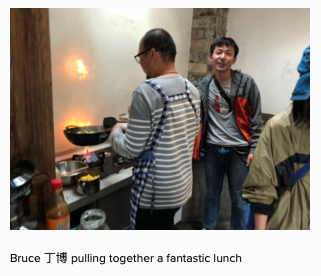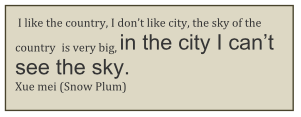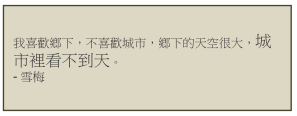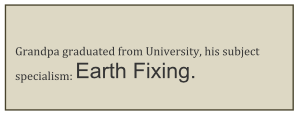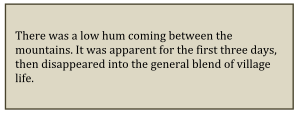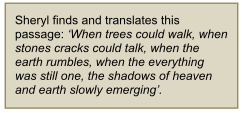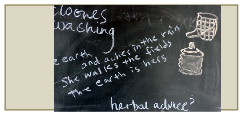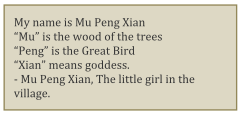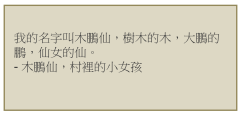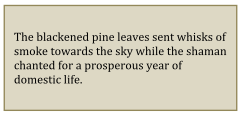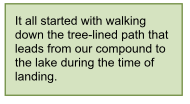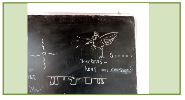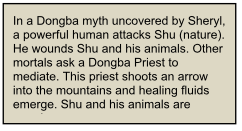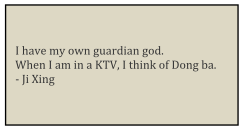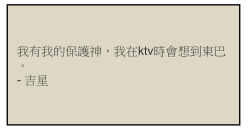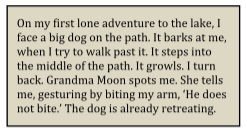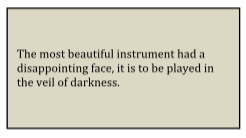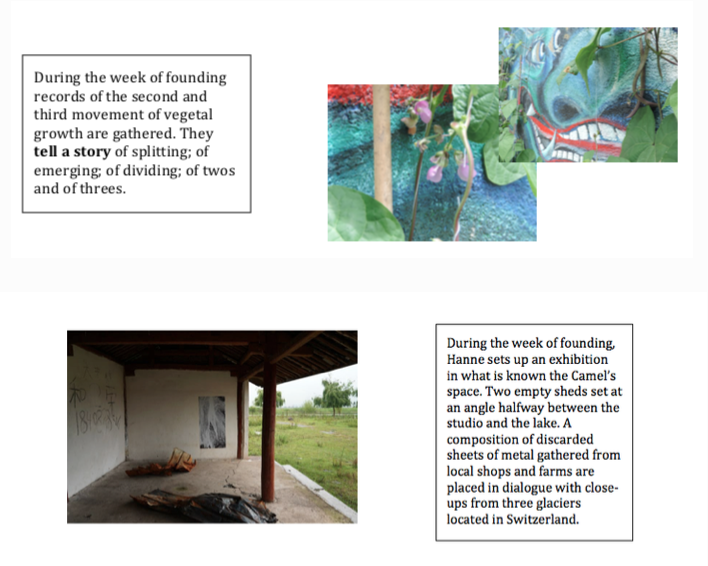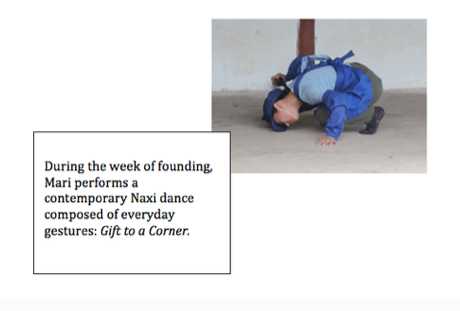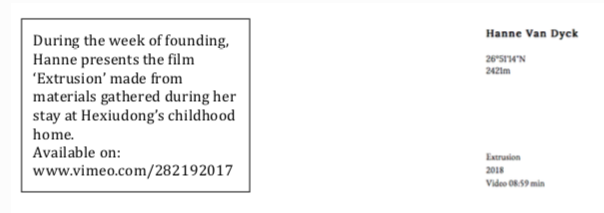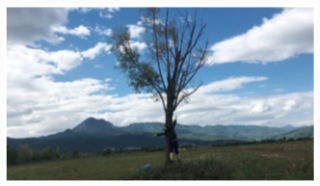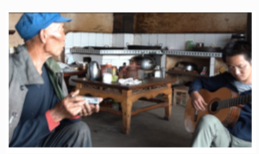MAPPING THE AFFECTIVE LANDSCAPE 2018
Records of the artist-led residency: In Sight of the Glacier
by
Petra Johnson
测绘情感景观 2018
一次由艺术家主导的驻留: 遇见,冰山一角
Petra Johnson 著
Book 1 May 14th – June 24th. 第一部 5 月 14 日 – 6 月 24 日
Chapter 1 Landings 第一章:着陆
Chapter 2 Groundings 第一章:着陆
Chapter 3 Findings 第三章:发现
Book 2 July 9th – August 6th 第二部 7 月 9 日 — 8 月 6日
Chapter 4 Between Landings and Groundings. 第四章: 着陆与扎根之间
Chapter 5 Founding(s) 第五章: 创建
Book 3 August 9th – September 6th. 第三部 8 月 9 日 — 9 月 6日
Chapter 6 One Day in a Week of Grounding. 第六章 :体验“扎根周”中的一天
Chapter 7 Acts of Founding. 第七章: 创建
Book 4 September 30th – October 28th. 第四部 9 月 30 日 — 10 月 28日
Chapter 8 At the Close of the Week of Grounding. 第八章: ‘扎根周’结束
Chapter 9 A Book of Findings 第九章:《发现之书》
(Witold von Ratingen; Kartika Mediani; He Jixing; Qingwa; Wu Shuyin; Adrian Tyus; Petra Johnson)
INTRODUCTION & CONCEPT
In 2017, we instigated the DuDu project which invited artists who had been at the studio before for a return visit. One of these artists was Petra Johnson, who had first come to the village in 2006. Petra has been working on and off with dancers since 2008 and recognized the immense potential of Lijiang Studio for poly-disciplinary (action-oriented) peer led gatherings. Petra first initiated poly-disciplinary gatherings during her residency at Swatch Art Peace Hotel (2014/5) and continues to do so at the College of Design & Innovation at Tongji University.
For Lijiang Studio she developed this concept (English/ Chinese).
The criteria for selecting artists/researchers begun by putting forward a range of disciplines. In order to invite recommendations, this initial list was shared with those who have worked with Lijiang Studio over a long period of time and are sensitized to the specific circumstances of this unique setting.
简介与概念
2017年,我们发起了‘嘟嘟’项目并邀请一些艺术家回访。Petra Johnson是其中一位艺术家,她于2006年首次来到这个村庄。自2008年以来,Petra一直与舞者保持着良好的合作关系,了解丽江工作室在跨领域合作、共同学习、实践方面的巨大潜力。Petra在斯沃琪和平饭店艺术中心(Swatch Art Peace Hotel)驻留期间(2014/5)第一次发起多领域聚会,接着在同济大学设计创意学院继续进行这种工作方式。
她为丽江工作室书写了这个概念 (英语/中文) 。
项目首先确定相关学科/领域,形成初步的受邀者名单。我们与曾和合作过的、熟悉工作室运作的实践者分享这份名单,并邀请他们推荐合适的人选。
RESIDENCIES 2018 We now have four blocks of gatherings, with the first one, titled “Under the Glacier“ starting May 14th, 2018. The participating artists from Vietnam, the UK, Canada, Taiwan and China will be introducing themselves in due course. The second block is in July, the third in August and the fourth in October. Each block brings together different individuals from a wide range of practices and a wide geographical area. The four week blocks are structured as follows:
A week of finding
A week of founding
Whilst artists are free to pursue their agenda, we will be holding open studio sessions (mounting of enquiries and processing with other minds) on Sunday evenings and meet every Tuesday for study sessions of chosen texts that assist in linkage making and relating experience to larger contexts.
2018驻留
我们目前举办了四个时间段的驻留, 第一次驻留名为“在冰川下”,于2018年5月14日开始。驻留艺术家来自越南、英国、加拿大、台湾和中国大陆。 其余三次驻留陆续在7月、8月和10月开展。每组驻留汇集了来自不同领域、不同地域的实践者。
四组驻留的结构如下:
第一周:着陆
第二周:扎根
第三周:发现
第四周:创建
艺术家们可以自由地拟定自己的议程并进行实践,同时,我们在每周日傍晚举行公共讨论会进行交流。此外,每周二我们也会一起讨论文献,建立联想,将个人体验挂钩到更大的环境。
DOCUMENTATION
The framework for documenting this residency program is a map, a map of lines made by and from walking. The paths and roads that link locations in Jixiang Village and that link Jixiang Village with the nearest market towns can - pre-dominantly - trace their origin to paths made by walking, specifically
a web of paths walked for mutual visits and shared participation in funerals, weddings, and festivals
interlinks with
the branched structure of roads made for market exchange and bureaucratic transactions.
Paths and roads drawn from memory of walks made with companions in 2017 formatted at x -21.24
The key to this nebulous map will emerge with and through each artist’s encounter with the locality; with a coming upon locations that ask for/inspire site-resonant lines of investigations. This collaborative enquiry toward an embracive domain view – literally a walk of widening circuits ‘toward the right hand’ – might help to reformulate given conditions for both artists and our hosts, as well as discover new co-ordinates.
Petra would like to thank all of the artists for their pro-active responses as well as Jay Brown for his thoughtful support and Dava Wing for concise and fluid matchmaking, literally done on a wing
过程记录
我们走了很多路,把路绘制成了地图,用地图建立此项目的记录框架。想要了解吉祥村,就得了解这些步行小路。这些交织着的小路方便村民互访,是所有葬礼、婚礼大小节日的必经之路;这些路不仅刻画出村里的社交关系,也交代了所有交易性质、行政性质的互动,时而分歧,时而汇聚。
这张地图交代了每位艺术家与各个地方的交流与邂逅;他们的研究都紧抓住某个地点的独特条件,因而得到启发或有所联想。这样的合作与探索可以激发宏观、多元的观点;能扩大视野,走出局限(想想看,一直沿着右手边走圈,圈越画越大,范围越走越多),帮助艺术家、村民重新认识自己的生活条件,在人生的地图上发现新坐标。
Petra在此感谢艺术家的积极参与,感谢 Jay Brown的支持和 Dava Wing为项目很快找到合适的人选,让合作如此轻盈顺畅。
LANDINGS
Book 1 May 14th – June 24th
Chapter 1 Landings
View of Jade Dragon Snow Mountain from Lijiang Studio, Jixiang village, Lashihai
Situated along the eastern margin of the Tibetan Plateau, Yulong mountain is located in the Hengduan mountain range in Yunnan Province, 25 km north of Lijiang. It extends 35 km from south to north and 13 km from west to east. With a highest peak of 5596 m, it is the southeasternmost glacierized area in Eurasia. The 19 glaciers on Yulong mountain, which have a total area of 11.61km2, are maintained by the southern Asian monsoon climate.
Peeping from between the ridges of two mountains into the window of our first floor studio is the snow covered peak of Jade Dragon Mountain.
What does it mean to work within the visual field of a glacier?
How many temporalities does a glacier contain apart from the most immediate of melting with every breath we take?
How many frozen life forms are re-animated?
Will the intimacy between earth and person, the weaving of our ’reading’ of earth and our ’reading’ of life take on a different shape and how might the documentation of our time together structure such an exploration?
What technologies of perceptions shape this particular gathering of
Sheryl Cheung
Xia Lin
Lucy Rogers
Quyen Nguyen
Jay Brown
Er Ge
Xuemei
Yen San
Amma/Anai
He Jiyu, 22 days away from taking his 高考
Bruce Bo Ding
Lao He
Nha Thuyen
Petra Johnson
During the time of landing, we hear that Nha, Yen San and Quyen cannot get a visa. Two poets and a ten year old boy described as a portrait maker, will not join us in person. We explore how to bring them into our gathering from afar, a poem by Quyen appears on the kitchen wall.
Landing, every detail, no matter how small matters during these first days, the nest the swallows built by the library, bad news, sharing a memory, an unexpected sound, the cherries dropping into our open hands at the slightest touch of a branch, young maize plants planted in zigzag lines.... the glacier. Surprisingly, it has been visible every day. Its steady presence allows the state of precariousness that accompanies landings to emerge at full blast. Simultaneously, this eye contact with the glacier nurtures trust in initial intuition and opens a dialogue, an investigation of temporalities and intimacies not yet encountered.
着陆
第一部 5 月 14 日 – 6 月 24 日
第一章:着陆
玉龙雪山坐落于青藏高原东缘,是横断山脉经过云南省的一部分,距 丽江约25公里。它南北长约35公里,东西长约13公里,最高处海拔5596米,并育有亚欧大陆距离赤道最近的冰川。在南亚的季风气候 下,玉龙雪山分布有19条冰川,总面积达11.61平方千米。
从工作室一楼的窗户向外望去,显露于两峰之间的,正是被积雪覆盖 的玉龙雪山。
在看得到冰川的地方工作,意味着什么?
除了随着我们的每次呼吸而不断地融化,冰川蕴含的时间性还有哪些 ?
又有多少被冰封的生命形态被重新激活?
身土之亲密与对土地和生命的“阅读”交织起来,会否有所变化?而我 们对在此度过的时间的记录,又将怎样组织这样的探索? 对土地的“阅读”与对生命的“阅读”交织,对于我们在此度过的时间,
怎样的感受将会塑造我们这些人的相聚?
张欣 Sheryl Cheung
大侠 Xia Lin
露西·罗杰斯 Lucy Rogers Quyen Nguyen
正杰Jay Brown
二哥 Er Ge
雪梅 Xuemei
和士元,爷爷 和淑芬,奶奶 和吉宇,还有22天就要高考 和吉星
Yen San Amma/Anai
丁博 Bruce Bo Ding Lao He
Nha Thuyen
佩雀 Petra Johnson
在落地的这段时间里,我们收到消息 ,诗人Quyen和Nha以及他们十岁的宝 宝Yen San因为签证问题而无法加入我 们。但我们仍然想把他们从遥远的地 方带到我们身边,于是厨房的墙上就 出现了Quyen写的一首诗。
在落地的过程中,每个细节——无论 多么细小——都是非常重要的:书房 屋檐下的燕巢,坏消息,分享记忆,
意外的声响,轻碰枝桠便跌落手心的果子,之字型种植的玉米......还 有冰川。令人意外的是,我们几乎天天都可以见到它。巍立不动冰川 更加剧了伴随落地而来的不确定感。与此同时,与冰川的目光接触也 灌溉了最初的信任,并开启了关于时间性的对话和探索,以及那尚未 相遇的亲密感。
GROUNDINGS
Book 1 May14th – June 24th
Chapter 2 Groundings
Grounding is a process of identifying context, of beginning the never-ending process of understanding that makes a location possible, and the stories that describe it's emergence: a world in formation, when things move(d) into being.
Here, in and around Jixiang Village, the necessities that emerge(d) from these movements were once re-enacted annually in the name of the earth spirit. They were chanted rather than physically re-traced. In a spiraling fashion, the chanted journey swept all the good toward this location, the body of the village. In such a chant, "the cadence walks where the entity it leads walks and rests where it rests." (Mueggler; 2001; p.247)
扎根
第一部 5 月 14 日 – 6 月 24 日
第二章:扎根
扎根是项永无止尽的过程,必须不断了解身处的环境,才能找到自己身处的位置,找到自己的故事,看清世界的变迁,明白万物的形成。
过去,吉祥村每年都举办仪式祭拜大地来实现“扎根”。人们通过念唱,而非行走,将附近所有的正能量吸引到村子里。念唱的“韵律引领着存在的整体,并反过来回应着这个整体,或动或停” (Mueggler; 2001; p.247)。
ARRIVING IN INCREMENTS
'What does it mean, the location as our curator?' What is required for the process of curing: A vessel? A twinkle in a locals' eye? A channelling of energy? All of these help to alter, to solidify, to gel.
What questions are better asked from here than elsewhere?' What is it about this location that alters as it contributes to sensation, to affect, to life, to thought, and to a deeper politics?
Or to ask differently, what nooks and crannies; which niche of the artistic imagination can flourish here, where rhythm and timescales are of a different order?' What does it mean to become present in a world in which' objects and daily life pose a challenge to the very logic and contemporary reasoning of the functioning of the world?'
纷纷莅临
“让地点成为策展人,这意味着什么?”酝酿过程中需要什么条件?一个容器?当地人眼神里闪烁的光芒?对能量的引导?以上皆扮演着改变,凝固,融合的角色。
相较于其他地方,这里更适合提出什么样的问题?
这里有什么特质能够影响感官、情动、生命、想法、甚至政治?在这些过程中这个地方本身发生了什么改变?
换句话说,这里的角角落落能培育什么样的艺术?什么样的艺术想像能在这里特殊的节奏和尺度获得滋养?
这里的物件和生活似乎并不符合世界发展的逻辑和当代理性。在这样的世界里,活在当下该是什么样子?
During the time of landing, like a body just pregnant, there are moments of repulsion, there is discomfort, there is a visceral sense of disorientation. The urban body needs time to adjust.
By contrast, the second week of our stay is a time of rhythmic alignments; different modes of engagement with the location emerge. What is it that keeps one of us in the compound and another traversing the village in circles, and yet another to-ing and fro-ing in a star-shaped configuration from one end to the other of the farm, to the lake, to the local village shop. Is it simply that these forms of movements serve our different practices?
Moving through and along local buildings, past multi-crop fields, bulging haystacks and bundles of twigs by the wayside - sticks that shine bright red in the rain and return to a dull grey-brown once dry - we are embedded in craftsmanship and a confident aesthetics, a dramatic textural difference from the urban context. These line any of the passages either of us move along, no matter how and for what purpose.
What is necessary to be here, 'to be present?'
着陆这段时间,我们有时感到不适,甚至反感;就像怀孕的身体一样,感到一种失调。习惯城市的身躯需要时间调适。
相比之下, 在第二周,我们做出节奏上的调整;我们尝试用不同的交流模式与当地交流。是什么让大家选择在不同的空间活动:一个人在大院里徘徊,另一个人绕着村子转,还有人在农场、湖泊、村里的店铺来回,以星形的路线在这里穿梭。这些不同的行动方式是否只是反映了我们不同的艺术实践方式?
穿梭于当地不同的建筑,经过田园和路旁的干草堆,以及一束束的树枝 – 这些树枝在雨中呈现出亮红色,干了却会退成暗褐色 – 这里的手工艺极佳,艺术造诣极高, 和城市的质感截然不同。它们大街小巷皆是,无论我们走到哪儿都能看见。
来到这个地方,要有什么必要条件?怎么样才能‘处在当下’?
What is our relationship to necessity?
In pre-Socratic times, chaos was understood as the source from which things moved into being out of necessity, out of having to be used. Here the story goes 'When trees could walk, when stone cracks could talk, when the earth rumbled, when the everything was still one, the shadows of heaven and earth slowly emerged'.[1]
In dongba culture the village is perceived as a body. Traditionally, at the beginning of the new lunar year, the elders (men only) would gather at a high point overlooking the village and chant a spiraling route. The route would set off from a city further afield, and as the chant circled toward the body that is the village, it would sweep all the good things toward it.
我们和必要条件的关系是什么?
在前苏格拉底时代,人们认为世间万物是从混乱中诞生的,因为有必要存在,因而生成。故事是这样的:彼时,树木能行走,石头上的缝隙会说话,大地低鸣着,世间万物仍是一体。这时,天与地的阴影慢慢形成了。1
在东巴文化中,村子被视为一个躯体。传统上,农历新年开始的时候,长辈(仅限男性)会聚集在一个俯瞰村庄的高处,高声念唱出一段旋转式的路径。这段声音路径从远处的城市盘旋向下,往村子的方向降去,一路将一切正能量旋风般扫入村子里。
Within this body/village, every space is being used and there are no formal boundaries. The things/ objects within and of this space have a distinctive quality: they carry a tactile memory. At this time of grounding there is enough familiarity to look and dig deeper, a time when things have not yet become so invisible that they cannot be separated from the self.
在这个身体/村庄内,每个空间都有功用,也没有正式的边界。属于这个空间的东西/物体具有某种特质 - 它们带有一些触觉记忆(tactile memory)。在着陆的这段期间,我们渐渐熟悉这里,能够观察或挖掘得更深——趁现在事物还没熟悉至隐形的时候,我们还有办法分辨自我与周边事物之间的界限。
A Peach and a Pumpkin
Here dinner is determined by what is growing outdoors, the weather, the mood. Likewise tools are adapted to the (human) body and the body locates places of rest indoors as well as outdoors, in furrows as well as by the fire or simply in the company of another crouching by the wheel of a car.
Any thing made can and is re-made or re-built. Even if the materials are different in the re-building, it will be considered to be the same, i.e. it serves the same neccessity. Everything around us is working according to a wide variety of life spans and lifetimes. It takes time and skill to tune into them: multi crop fields growing peaches and pumkins, being but one example.
桃子与南瓜
这里的晚餐上的是外头生长的一切,也由天气和人的心情决定。同样的,工具也被改造以适应人类的身体,而身体也决定人休息的地方 - 室内或室外、沟渠、火堆旁、即便只是蹲在车轮旁和他人聊天。
任何被制造出来的东西都可以被重新制造或重建,它们本身就是这种重造过程的产物。即使使用的材料不同,重造之物也会被认为和原物件是同样的,因为它们所满足的需要是一样的。我们周围的一切都有自己的寿命和生命轨迹。调谐这些不同的存在需要时间和技巧——例如,田地里既有桃子,也有南瓜。
-----
At the close of a pig roasting day last Thursday, 28th May, Er Ge proposed a toast "The earth belongs to us." Here, at the table outside the studio kitchen, in such diverse company, of lives lived in Beijing, Tacheng, Shaanxi Province, Jixiang Village, Taipei, Hongkong, Guangzhou, Lijiang, London, New York, Haidong Village and Shanghai, the sentence struck like an evanescent discovery.
Lijiang Studio, Jixiang Village, 4th June 2018
5月28日,星期四,这天是个大日子,我们烤了只猪。这一天快结束时,二哥给大家祝酒。他举着杯,说道: “这地球属于我们”。在工作室厨房外的餐桌上,这短短的一句话带来的可能性稍纵即逝。毕竟, 我们这群人在北京、陕西塔城、吉祥村、台北、香港、广州、丽江、伦敦、纽约、海东村和上海之间过着不同的生活。
丽江工作室, 吉祥村, 2018年6月4日
[1]Translation by Sheryl Cheung
References:
Lepecki, A. (2017) Decolonizing the Curatorial, avalaible at https://read.dukeupress.edu/theater/article-pdf/47/1/101/478963/THE_471_09Lepeck_FF.pdf
Mueggler, E. (2001) The Age of Wild Ghosts University of California Press
Kagis-McEwan, I. (1993) Socrates’ Ancestors MIT Press
FINDINGS
Book 1 May14th – June 24th
Chapter 3 Findings
Prelude
Before launching into Chapter 3 (Finding) of our residency, I like to share Sheryl Cheung’s ’Readings of a Landscape’ that emerged from her encounter with the location during the time of Landing and Grounding, see separate document.
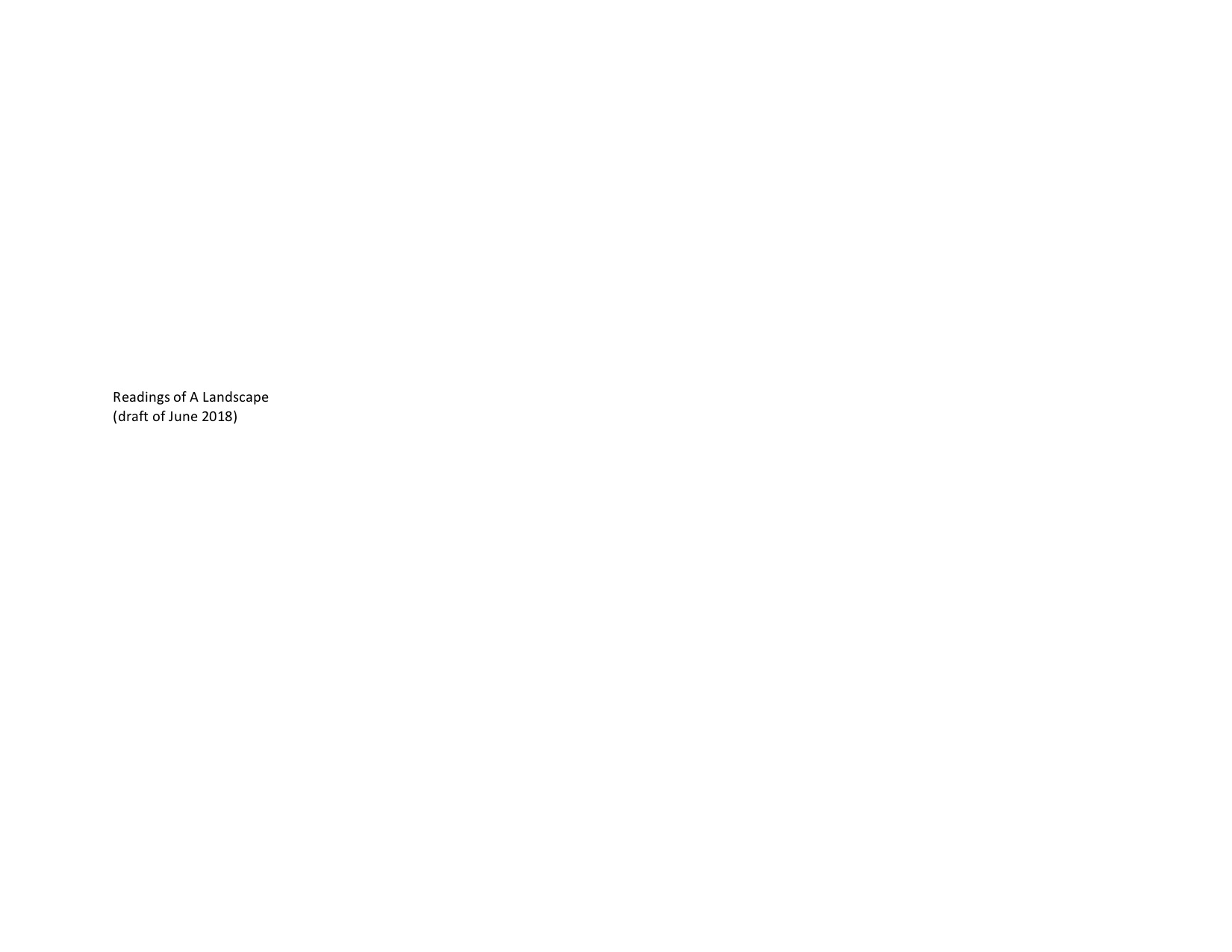
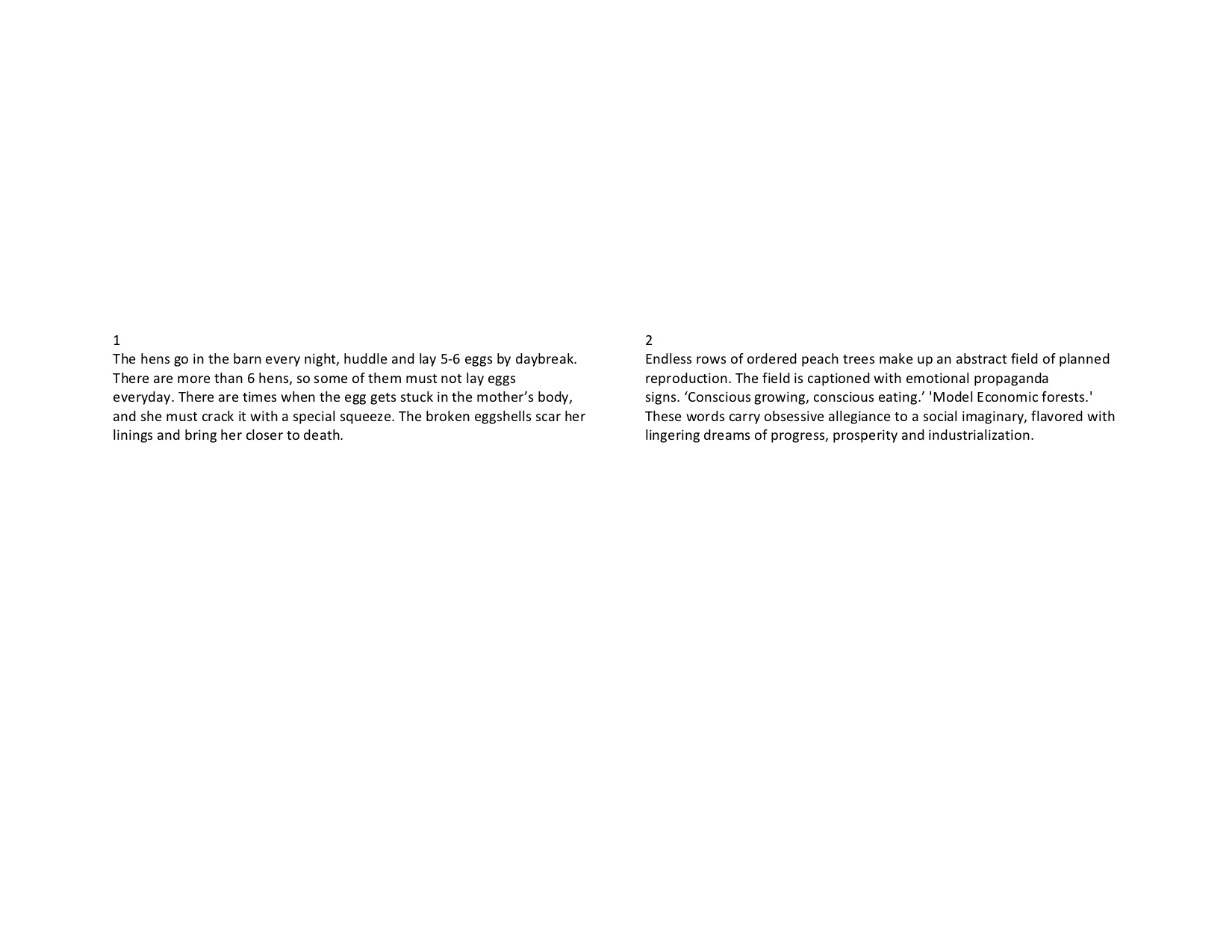

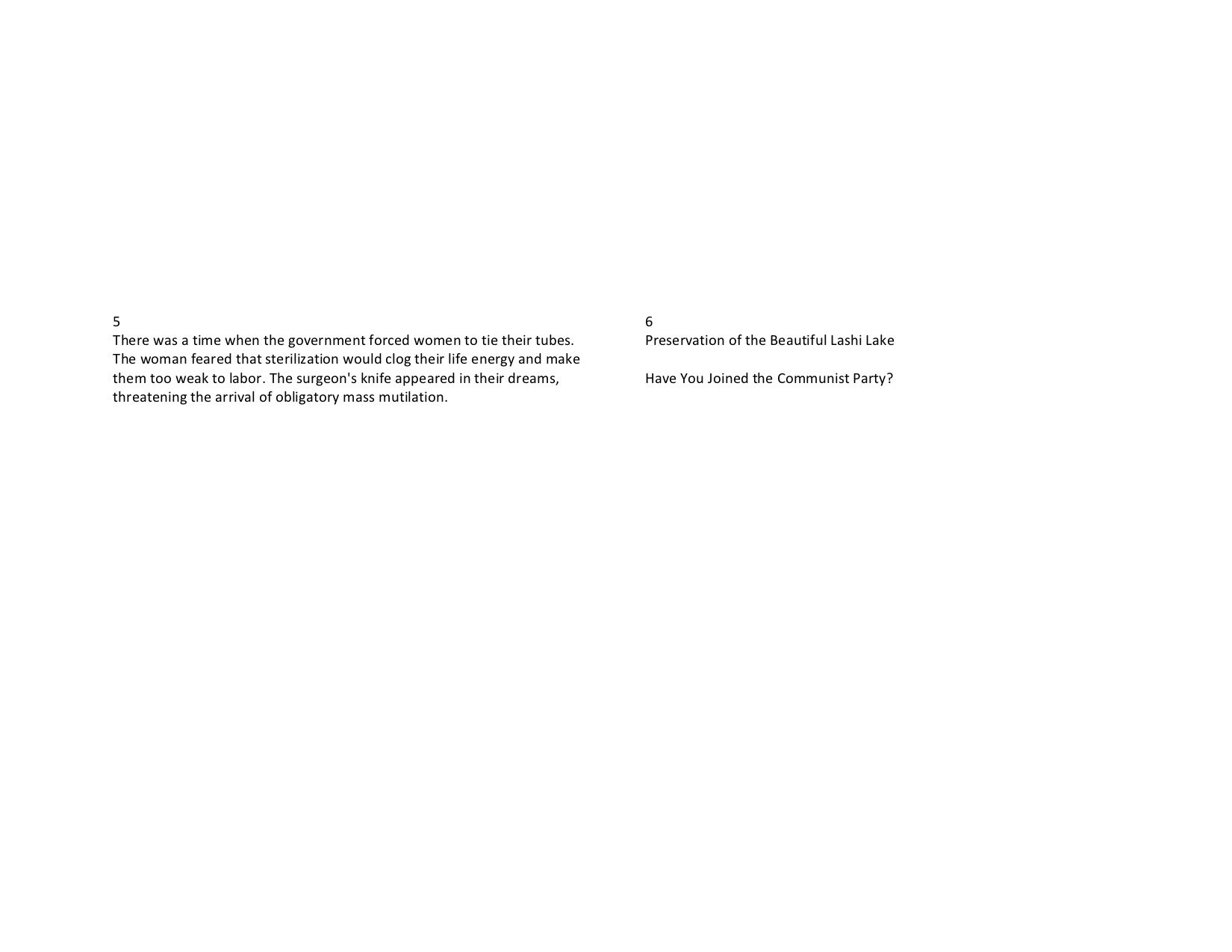
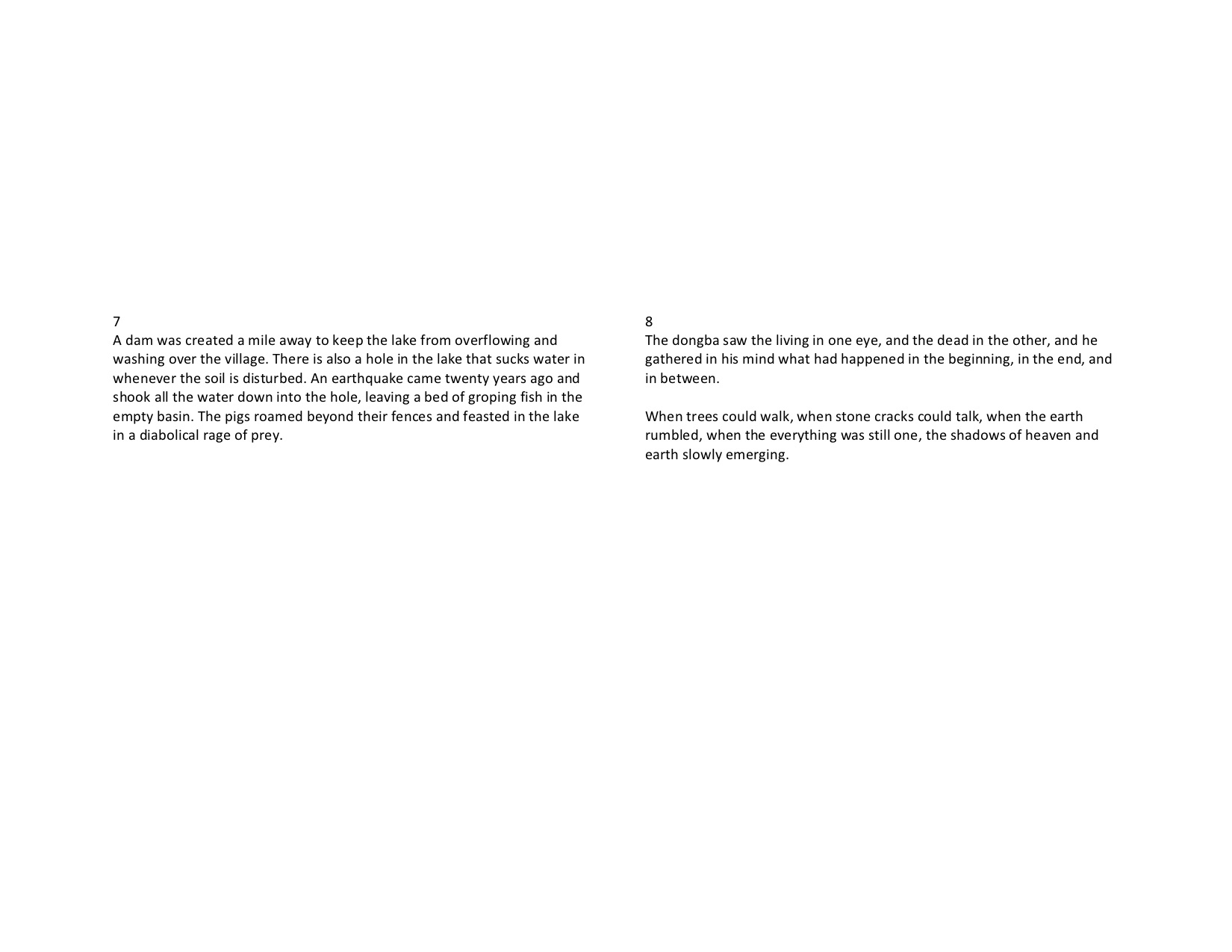

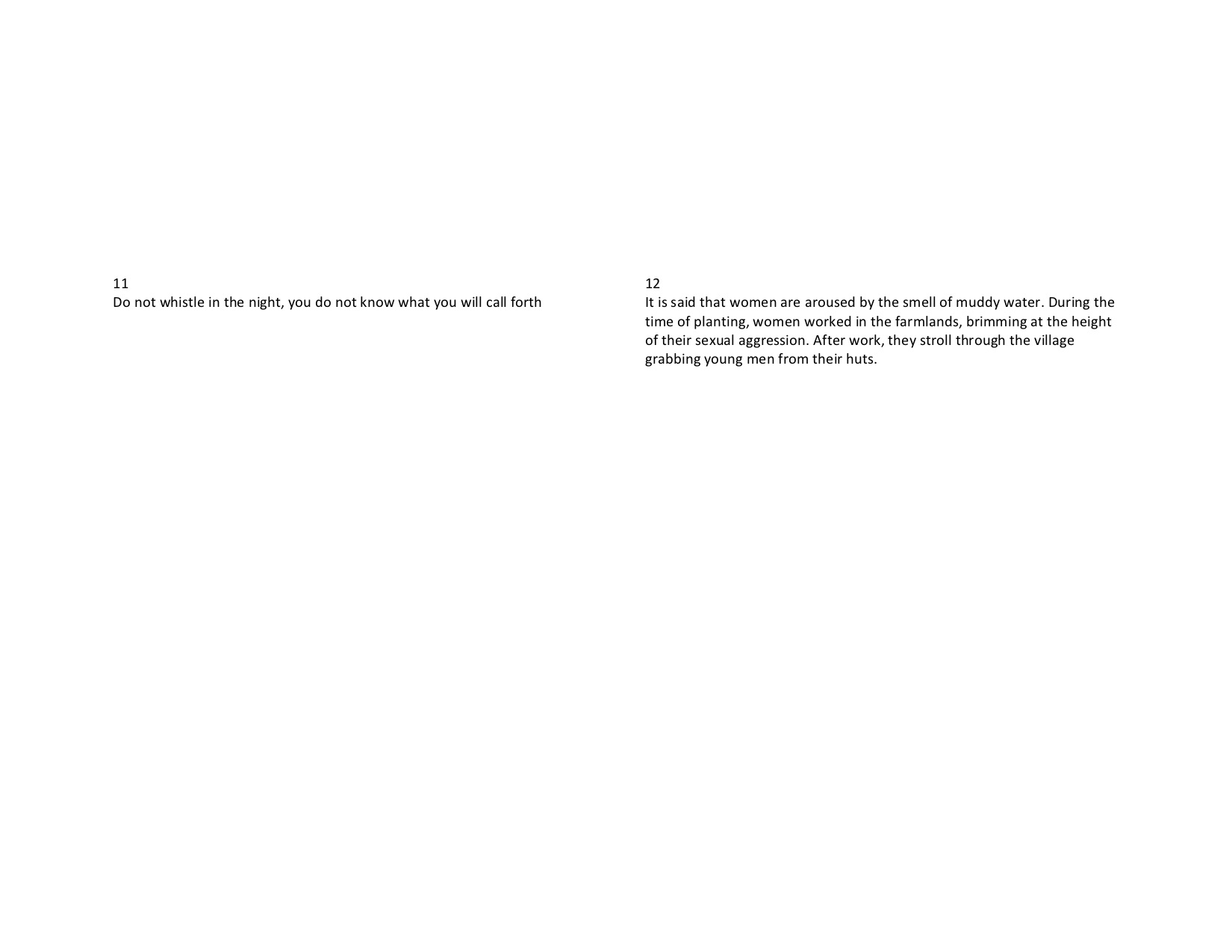
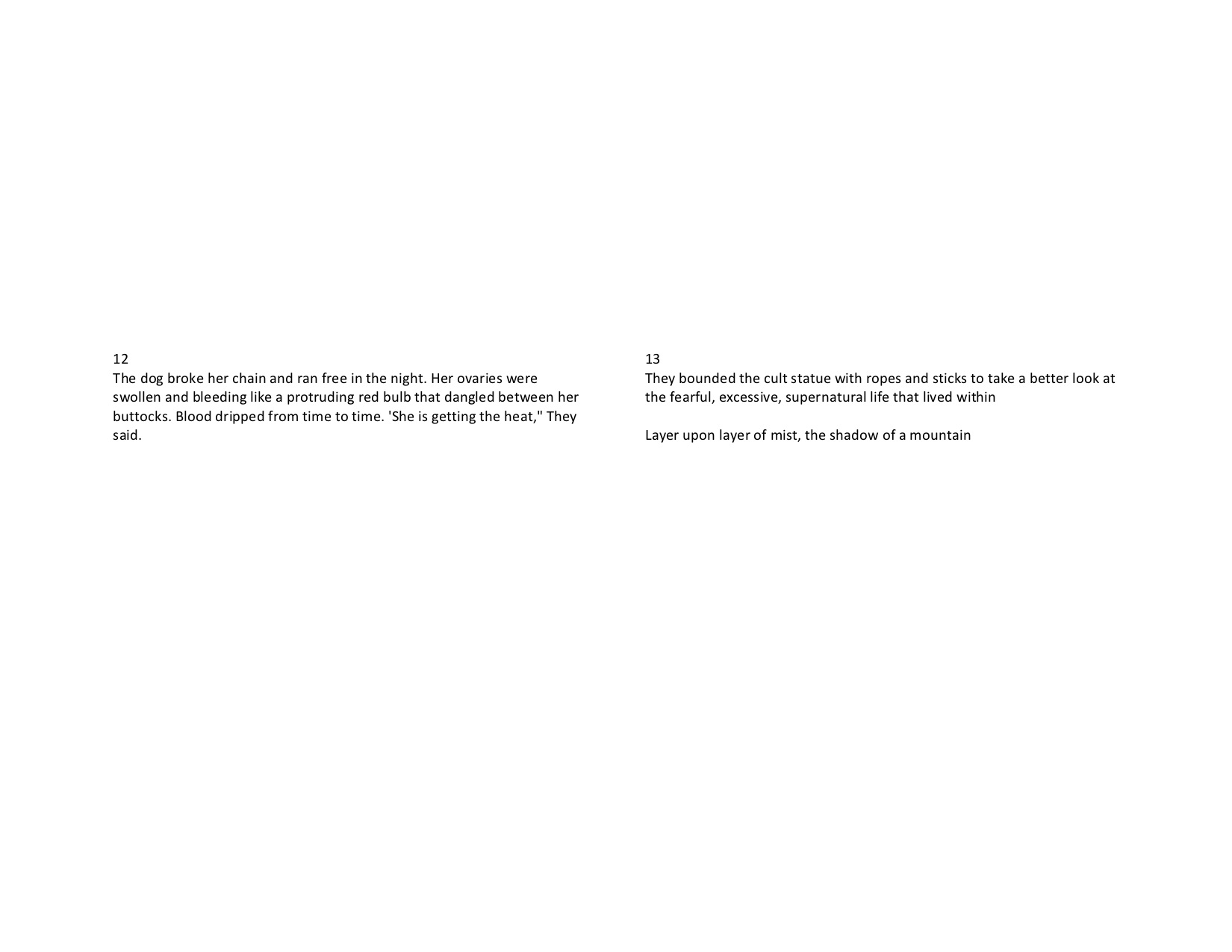
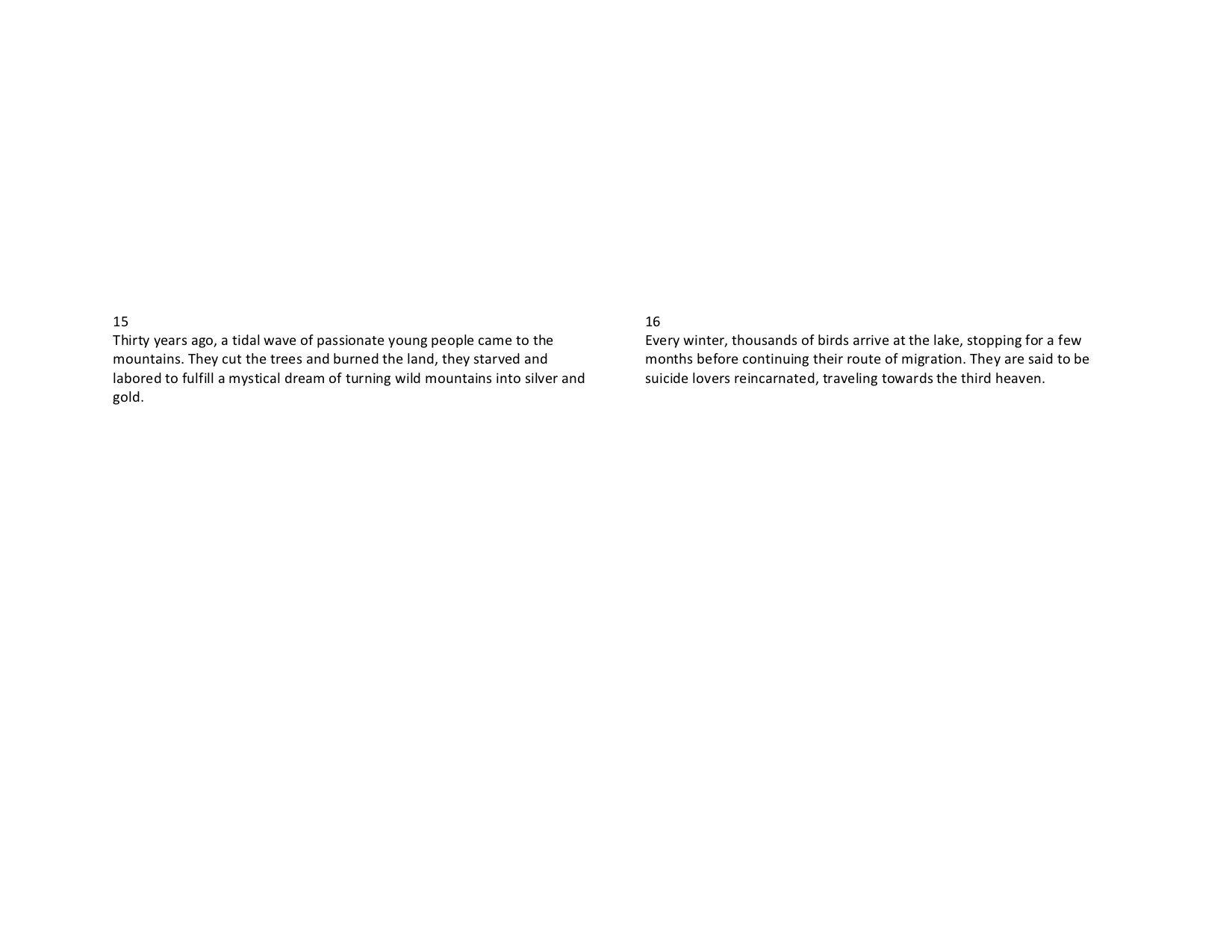
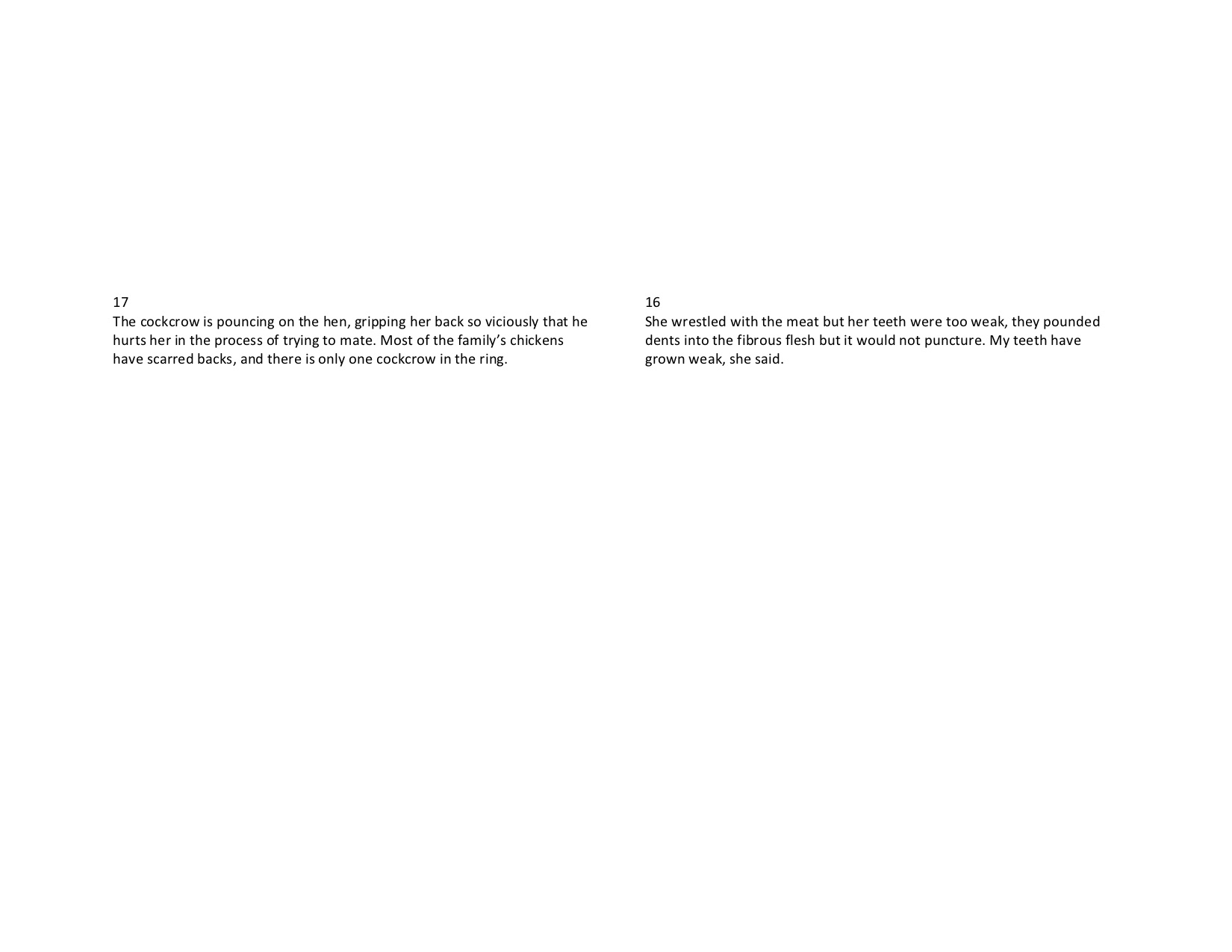

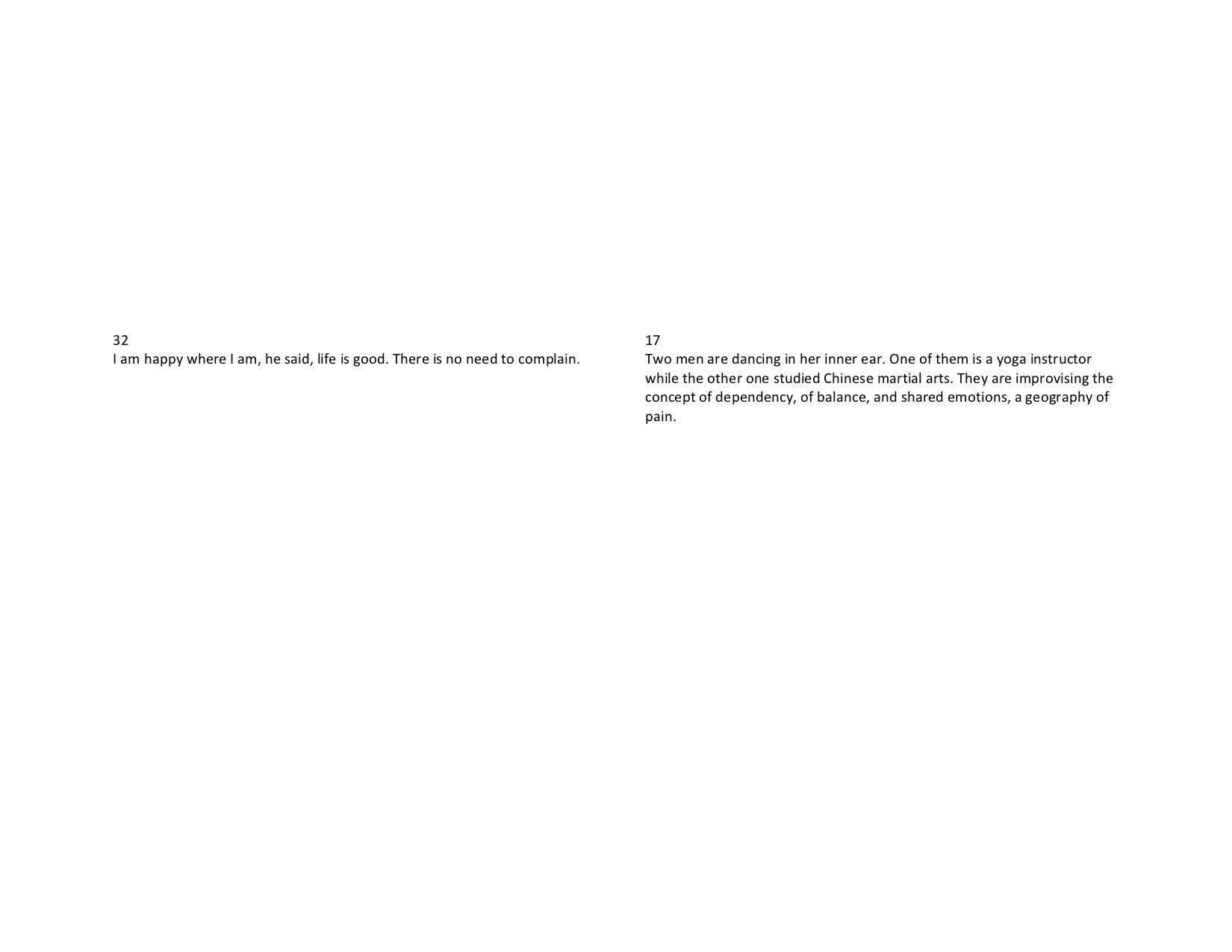
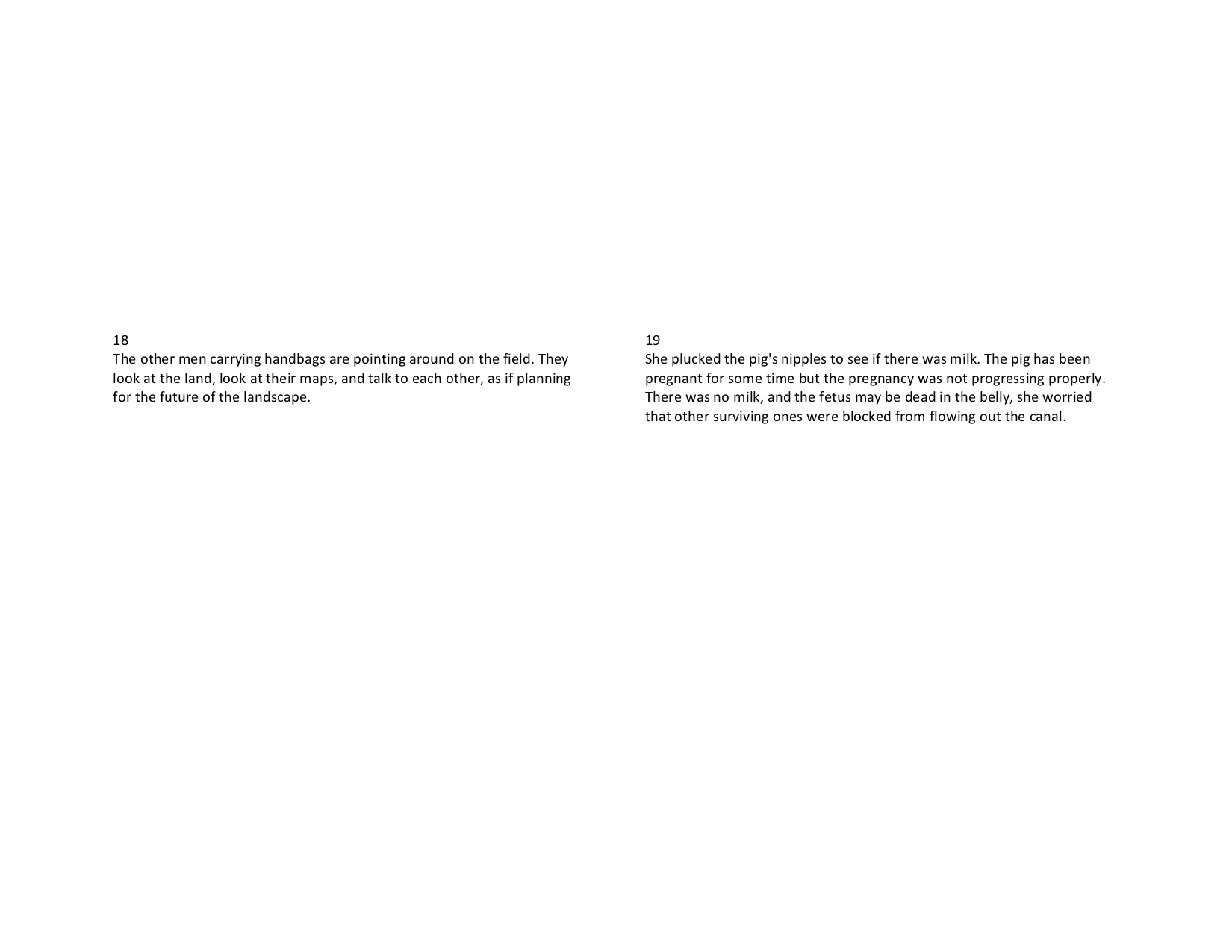
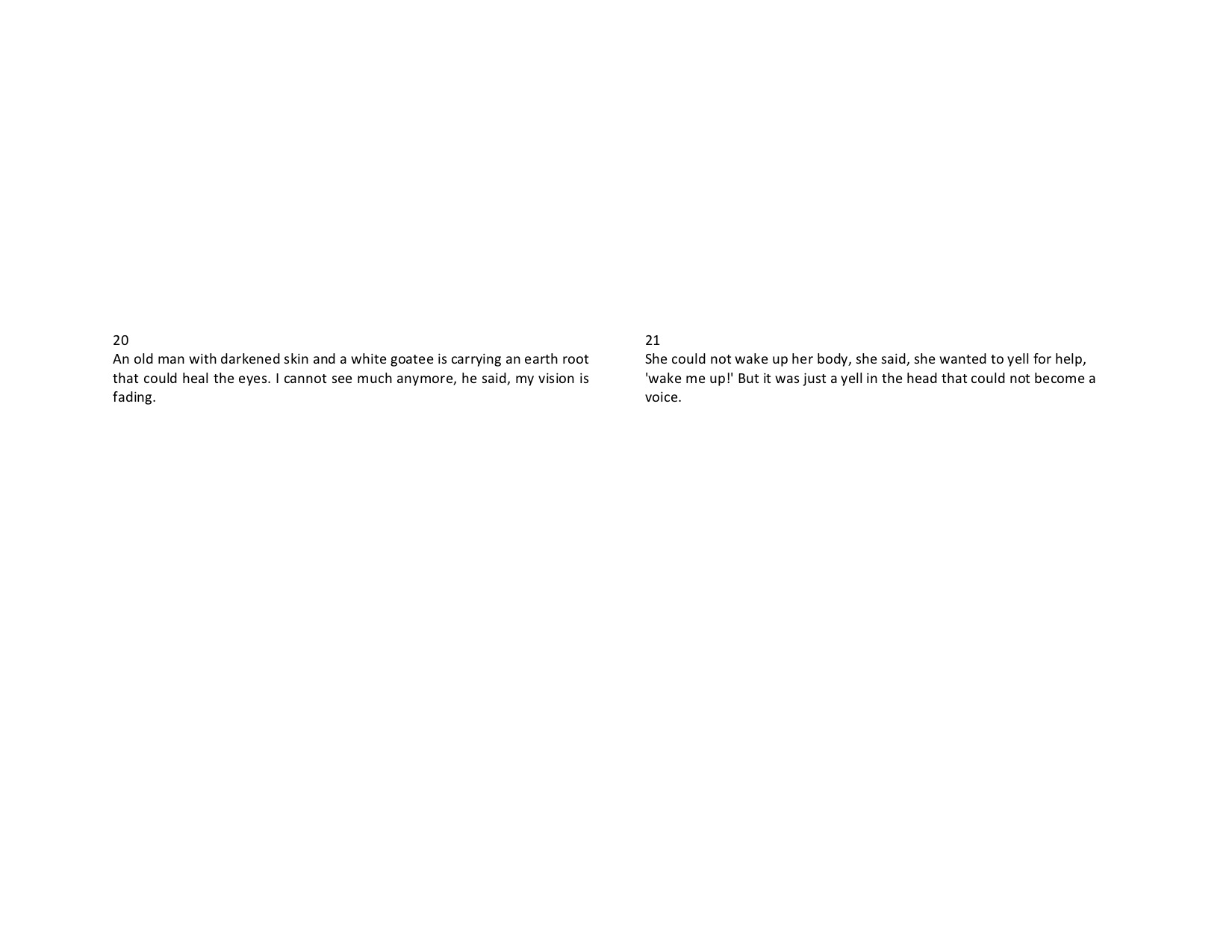
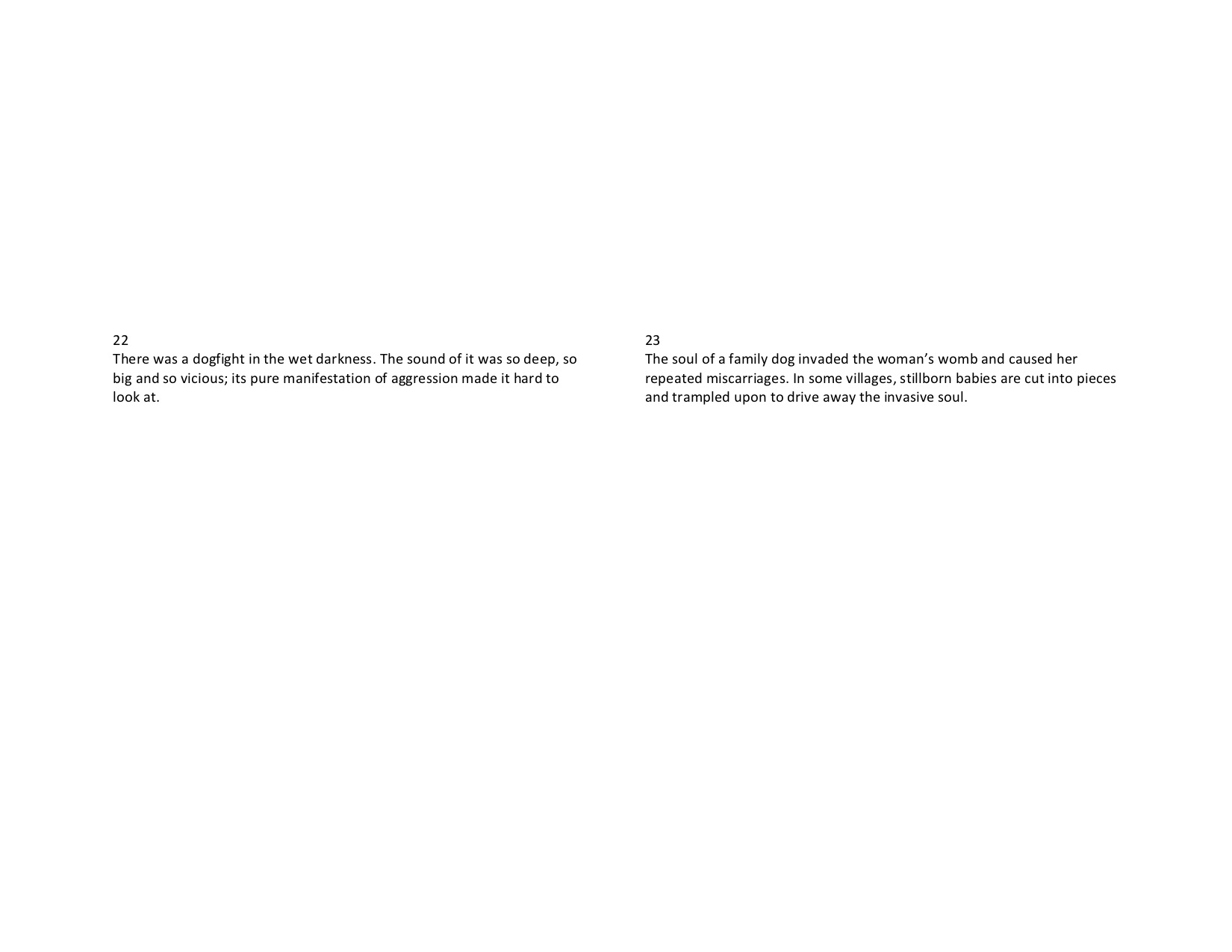
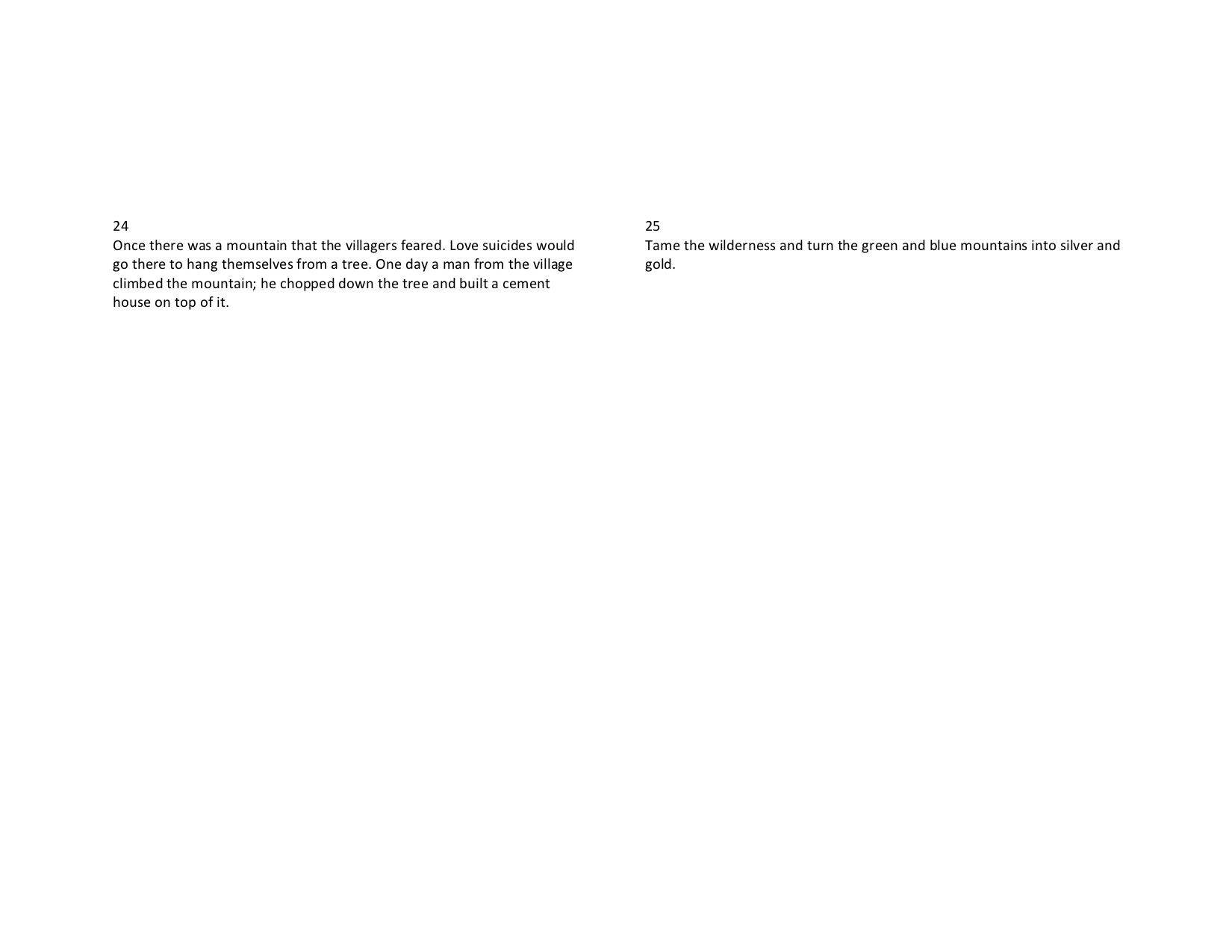
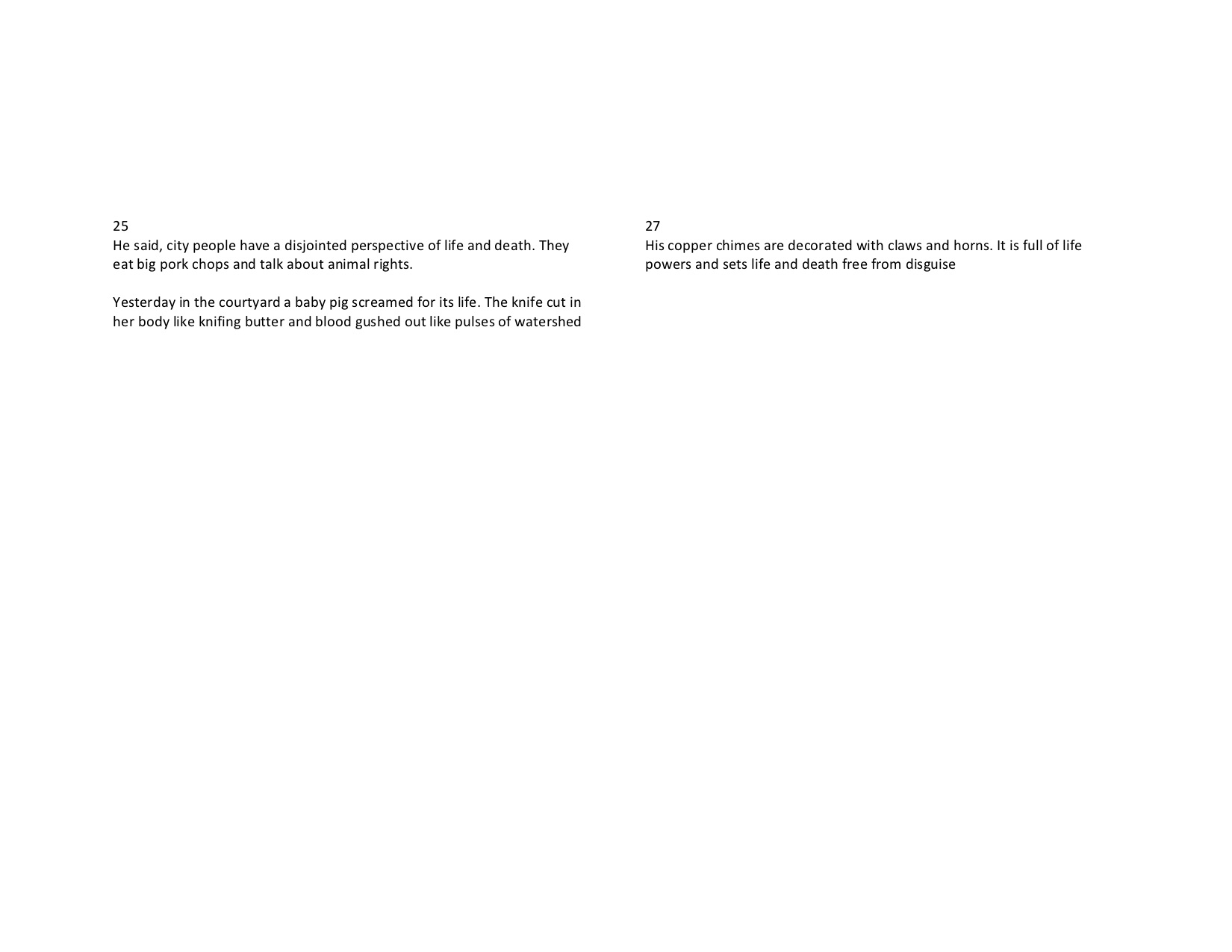



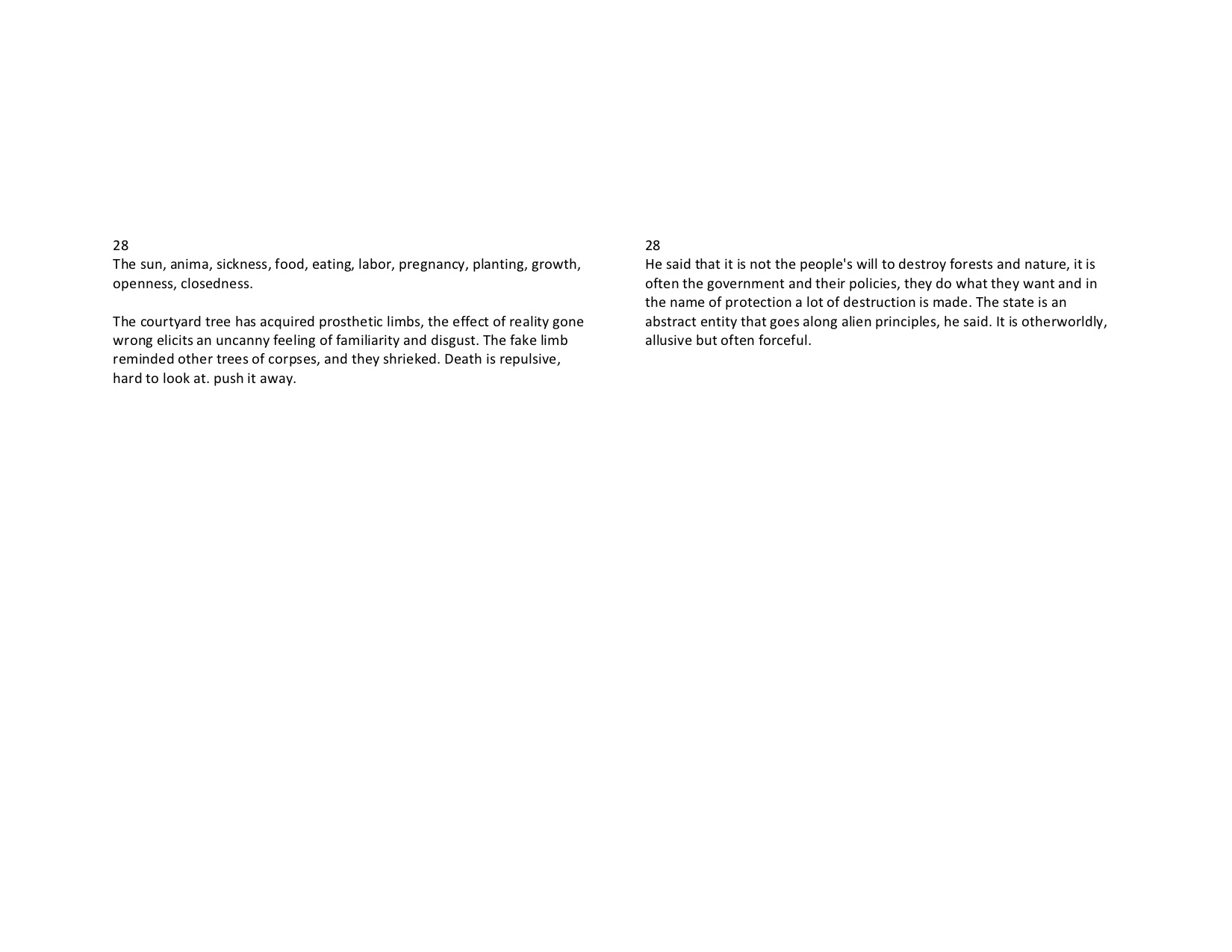

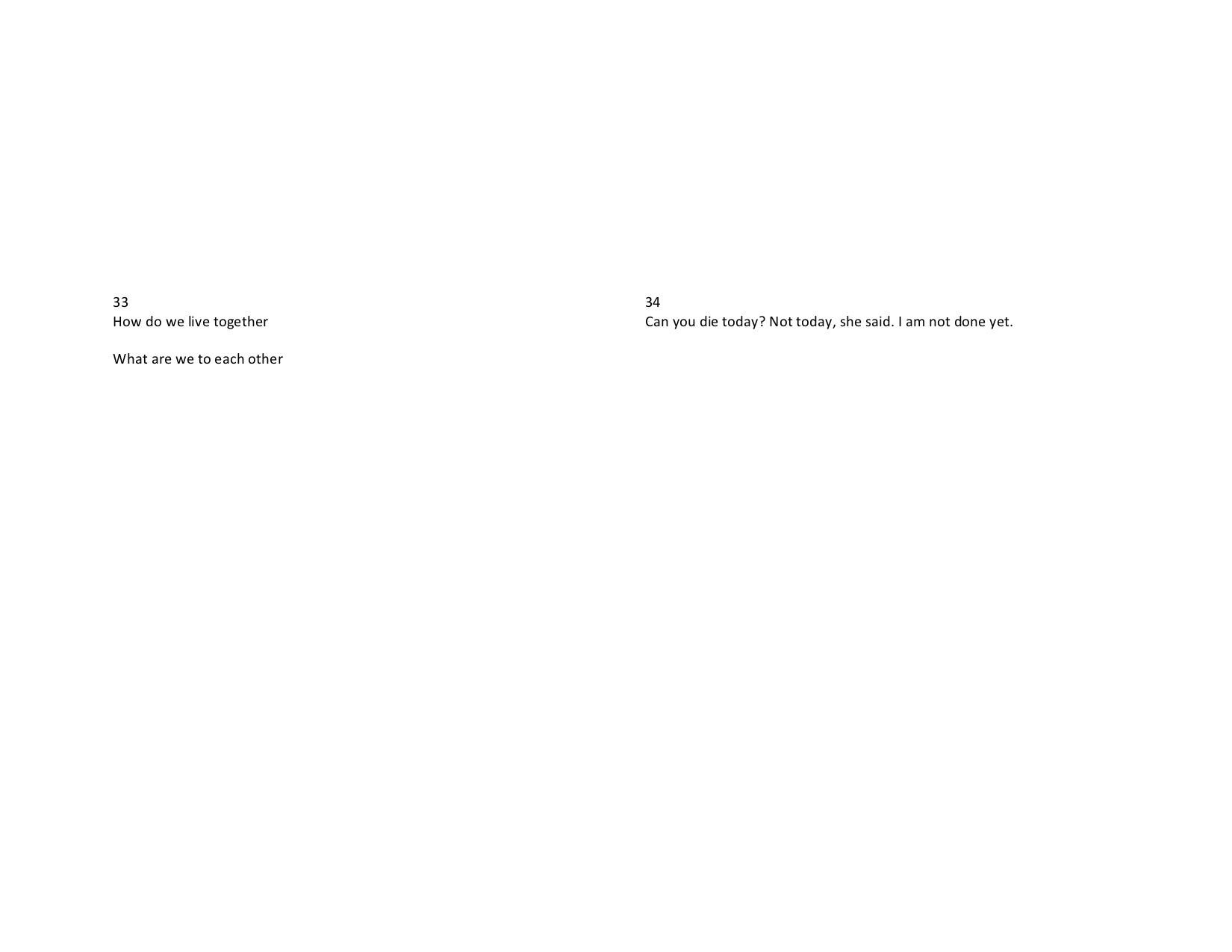
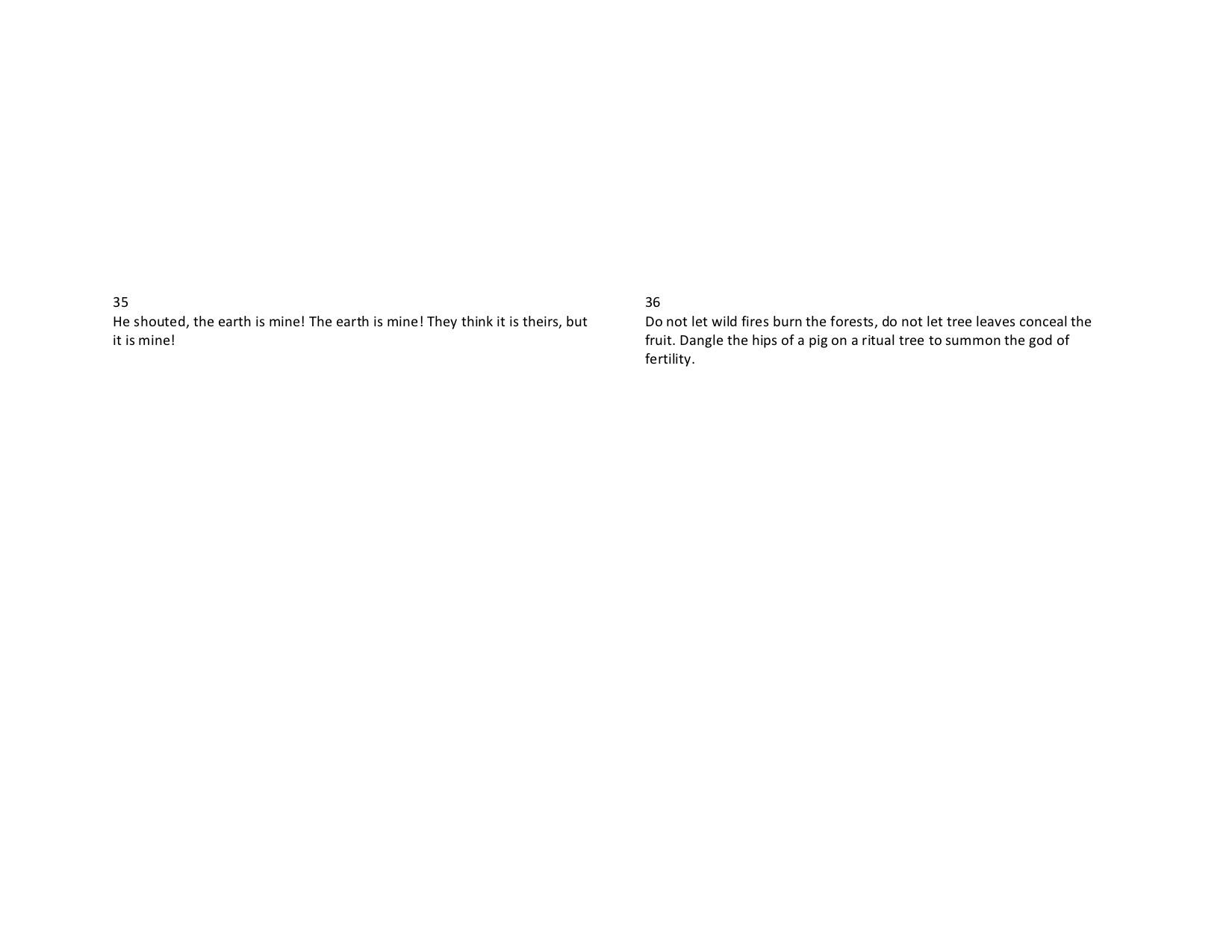
Another Prelude
During the time of grounding, the four baby swallows - now old enough to leave their nest - drew boisterous curves across the courtyard, linking the roof edge of the kitchen with that of the library with that of our sleeping quarters and back to the kitchen roof again and again. The directional forces of their flights reflect our movements on the ground.
发现
第一部 5 月 14 日 – 6 月 24 日
第三章:发现
前奏
在进入我们驻留经历的第三章 (发现)之前,我想分享 《景观的阅读》,其作者谢丽尔·张与当地的相遇启发了她的创作,与《Landing and Grounding》的创作时间同步。另见说明。
另一前奏
在人们对周围环境建立感知的过程中, 这里曾经四只小燕子躁动着在院子里画出热闹的曲线, 永不停息地把厨房的屋顶、图书馆的房顶、以及寝室的屋檐连在一起。现在这些燕子已经够大了, 可以离开他们的巢穴独立生活。它们飞行的方向和我们在地面上的运动不谋而合。
Chapter 3: Findings
‘Finding entails the act and process of searching as well as the outcome, the thing discovered,’ (Girot in Corner, J. 1999; 63)
The following is A Montage of Disparate Entities
and consists of five textual findings, one visceral finding and two movement-propelled findings by each resident artist:
第三章: 探索结果
"探索成果不仅牵涉到结论和被发现的具体事物,其行为本身和过程也不可或缺," (Girot 在角落里, J. 1999; 63)
下面这个汇聚多种元素的蒙太奇涵盖了五个文本探究结果: 一个是深层次的发现,另一个则是运动推动的结果:
The time of finding was guided by the question: Is that which has been found an object, an integral part of the landscape, an experience, a question, a possibility? In retrospect our discovery emerged once we joined an integral part of the landscape
- with an experience,
- with a question,
- with a possibility and with reflections about objects.
During the time of searching my footing became/has been uncertain; it has been exhilarated by the promise of unknown territory; it has been fatigued by t(h)reading across shifty terrain; it has been exasperated by the predictability of encountering the already known, whilst looking for it’s other.
探究的过程是以以下问题为导向的: 这就是被发现的对象吗? 它是景观的一个组成部分吗? 它代表着一段经验、 一个问题、还是一种可能性?回想起来,我们的研究发现似乎是伴随着我们对周遭景物注入的经历、疑问、对事物的心得而萌生的。
在我搜寻期间, 我的脚步变得飘忽不定,它似乎被未知的领土所振奋;它已因长途跋涉的起起伏伏而倦怠;它对已知的可预测性感到不可耐烦, 同时它也在不断寻觅着其它的领域。
Textual Findings 文本心得 (1)
and Textual Findings 文本心得 (2)
Movement-propelled Findings
运动启发的心得 (1)
Searchings do lead to discoveries.
Discoveries make themselves known by a moment of surprise
or the outcome of a systematic search. Discoveries share the ’I did not know that’:
a distinct quality of place; the door to an open possibility and/or the framework that supports one’s intuition.
探索的确引导发现。
这些发现成果以各种形式出现,或是片刻的惊喜;或是系统搜索的结果。所有的发现都代表了人们先前 的未知:对一个地方的独特性的未知;对通往可能性的那道扇门的未知,或实际支撑我们直觉的认知框架的未知。
Textual Findings 文本心得 (3)
Textual Findings 文本心得 (4)
By now we, resident artists, share the experience of being ‘in’ something. Our separate activities, experiences and observations are leading to emergences. Being synchronous in that we meet at mealtime and occasionally travel together, helps to alert us to the potential of a manifest moment, when all three previous stages become synthesized: A Founding.
当时, 我们这群驻留艺术家共同分享着一种“心无旁骛”的经验。我们彼此个体的活动、经验、和观察让灵感不断涌现。我们在饮食起居时的同步和一起旅行时的作伴都有助于唤醒我们对现实所隐藏的内涵的认识。当这三个阶段融为一体时: 一个发现就应运而生了。
Movement propelled Findings (2)
Coming back at 9.29am on the 23rd of May, I encountered a man seemingly talking to the trees. Once within hearing distance I realised the man was counting trees in sets of five. I sent a we chat message, wondering this observation might portend? Quyen responded from Hanoi. She suggested the man might be a cartographer, she recalled that children too count trees.
By 11.37am some trees had acquired yellow flags.
By 15.39 trees were being felled.
在 5月23日早上9点29分回来的时候, 我遇到了一个似乎在和树说话的男人。有一次, 我无意间听到这个人在以5棵树为单位数这些树木。我发了一条微信消息给我的朋友寻求答案, 不知道这一发现究竟预示着什么?身处河内的Quyen回复了我的消息 。她猜想这个人可能是制图师。在她的记忆力,当地的孩子也会数树木。
到了那天早上的11点37分, 其中的一些树木获得了黄色的旗帜。
当天的下午3点39分,所有的树都被砍掉了。
Visceral Findings 深度发现 (1)
We discover a shared question.
At the lower end of the trunk the felling of a tree begins with the shrieking of a saw followed by creaking sounds as fibres tear. Weighed down by the mass of the upper trunk’s crown and with more than half of their number already severed, the fibres hold on verticality is profoundly diminished. A couple of men pull a rope tied to the crown. The fibres stretch as they tear apart from each other, they groan and finally split.
我们发现了一个共同的问题。
在树干更低的末端,砍树的过程从电锯的尖叫开始,然后我们可以听到吱吱作响的撕毁纤维的声音。受树冠的重量所压,超过一半的纤维已经被切断,而 保持垂直方向的纤维寥寥无几了。两个人拉动着拴在树冠上的绳子。纤维彼此一面拉伸一面撕裂。他们呻吟着, 最后彻底被断开。
We meet Hexiudong, Dongba priest and mediator between nature (Shu) and human. A possibility emerges, maybe together we can find a way of processing our experience. Hexiudong explains that any form of encounter concerning nature and human would only be meaningful if it took place at the source of water.
我们遇见了何秀东,他是处于自然 (蜀) 和人类之间的东巴神父和传递者。一种新的可能性萌生了:也许我们可以一起找到一种方法来诠释我们的经验。何秀东解释道, 如果发生在水的源头,那么关乎于人与自然的任何形式的接触都是有意义的。
Textual Findings 文本发现 (5)
To be looking for a water source also makes sense for more domestic reasons: - we work in sight of the glacier; there is the proximity of the lake: Lashihai, where local fish comes from; there is the intricate irrigation system that lines and raises every road; and almost every late afternoon, we see Amma fetching drinking water from a well. And finally, as Hexiudong says and Timothy Morton writes, ’We all contain water in about the same ratio as Earth does, and salt water in the same ratio that the oceans do.’ (Morton. 51; 2011).
寻找水源对驻留生活本身而言也颇具意义:我们就在冰川附近工作,而且距离拉市海不远。拉市海汇聚了当地的鱼类,并且拥有覆盖支撑所有道路的错综复杂的灌溉系统;几乎每到傍晚, 我们都看到 Amma 从井里取水。最后, 正如 Hexiudong 所说和蒂莫西. 莫顿所写, ' 我们都含有与地球相同的比例的水, 和海水含盐比值相同的盐水。(莫顿 51; 2011)。
The first spring we visit is distant from the village and has become a tourist attraction. Rather than searching for another one we wait. We spent a morning in the Dongba library. In both, Dongba myth and Ovid’s tale, mortals take or fail to share what is beyond their need.
我们参观的第一个水源地是一个距离村庄不远的旅游景点。我们没有东寻西觅,而是在原地静观其变。我们在东巴图书馆度过了一个上午。在东巴神话和奥维德的故事里, 凡人都是因为自己无福消受的事物而遭遇不幸。
Movement-propelled Findings (3)
The following day, he takes us to a path off the local country road. A brick-making workshop; a power grid station and a pig farm line the path; the path leads us below the highway to a hollowed out mountain. Leaving the cavity behind us, we continue to climb up. Now we are walking alongside a small stream: part of it runs through a pipe and part of it runs freely. A small herd of cows and their calves graze in the woodlands. We clamber on following the sound of goats further up and find the source of the stream. We are traversing an integral part of the landscape.
第二天, 他带我们去了当地乡间小路。我们中途经过一个制砖车间、一个电网站、和一个养猪场线的路径;这条小路通向公路下的一座山洞。我们穿过山洞后继续顺着山道爬上去。当时我们正沿着一条小溪走着: 它的一部分被灌注到管道里, 另一部分自由地流淌着。一小群奶牛和它们的牛崽们在林地里吃草。我们沿着山羊的声音爬上去, 找到了小溪的源头。我们当时穿越的,是当地自然景观的一个不可分割的部分。
Epilogue
Why would the tenor of the statement made by Erge ’The earth belongs to us’ be an ’evanescent’ discovery, a possibility; a fleeting sense of potential to someone like myself who experiences the earth as belonging to itself:
as an entity that cradles my walks (in the city as well as here);
as a detached observer (when amongst trees, fields, mountains and along rivers)
and as an aspiration (when watching/drawing seeds/seedlings turn into plants/fruit/flower/vegetable).
The mesh that informs my experience of an evanescent discovery; the ’I did not know’ response to Erge’s statement is shaped by an environment in which nature is a commodity and in which a sense of entitlement that has faith in human ingenuity to fix any harm done, prevails; in which personal growth needs self-made challenges and in which external influences prevail. As Sheryl noted, both of the myths mentioned above are set outdoors where mortals are often vulnerable to external influences.
By contrast, when sustenance is the goal, durational circular relationships form.
Lijiang Studio, 18th June 2018
结语
为什么 "地球属于我们" 感言中的论调代表着一种“逐渐消逝”的发现, 一种可能性,以及对像我这种亲身体验过地球独立性的人来说, 一种转瞬即逝的潜能感:
地球是我脚步的摇篮 (不论在城市还是这里) ;
地球一个独立的观察者 (在树木、田野、山脉、河畔)
地球是一种向往 (当播种时、观察水果时、和花卉或蔬菜的幼苗成长时)
在我看到的地球上,自然是为人类所用的,人类的主观能动性可以平复一切。正是这个特殊的环境丰富了我对“逐渐消逝的发现”的认知,也是它激励着我用一句“我原来不知道”来回应Erge的声明。 是由一个环境, 其中自然是商品, 并在其中的权利感, 有信心的人的聪明才智, 以弥补任何伤害, 盛行;人类必须要挑战自我才能不断成长, 而外在的影响才是最普遍的。正如谢丽尔所指出的, 上述两种神话都是在户外设置的, 在那里凡人往往容易受到外在的影响。
相比之下,因为向往生存,所以生生不息
丽江工作室,2018年6月18日
References & Further Reading Material:
Corner, J. (1999) Recovering Landscape Princeton Architectural Press
Lippard, L. (1997) The Lure of the Local New Press, NY
Morton, T. (2011) Objects as Temporary Autonomous Zones, continent.1.3 (2011) 149-155
Morton, T. (2013) Hyperobjects University of Minnesota Press
Mueggler, E. (2011) The Paper Road, University of California Press
Ovid (1971), Metamorphoses, transl. F.J. Miller, Harvard University Press
Stewart K. in Gregg, M. et al (2010) The Affect Theory Reader Duke University Press
Stewart, K. (2013) Tactile Compositions available on https://www.academia.edu/4240807/Tactile_compositionsNot_For_DistributionNot_For_DistributionNot_For_Distribution_Tactile_compositionsNot_For_DistributionNot_For_Distribution
1. ‘Nearly every Dongba ritual act includes a meticulous accounting of and restitution for incursion upon the nonhuman world’ which are perceived as transgressions upon the initial contract between human and nature, two brothers with different mothers. (Mueggler. 2011; 97)
几乎每一个东巴礼仪法案都包括对人类世界在被入侵洗礼后的重建, 这被认为是一种对人与自然的最初契约的违反, 二者就像一对同母异父的兄弟。 (Mueggler. 2011; 97)
Between Landings and Groundings
Book 2 July 9th – August 6th
Chapter 4 Between Landings and Groundings (Chin/Engl)
Movement without Doubt 确信无疑的运动
第二部 7 月 9 日 — 2018年8月6日
第四章: 从落地到生根
A Family of Emergences1 Seeking A World
On living with a Wal-Mart over the mountain, anthropologist Kathleen Stewart writes,
‘It was then that I begun to think, along with others, that nameable clarities like family or friendship or love or collapse or laughing or telling stories or violence or place are all bloom spaces. They are all forms of attending to what is happening, sensing out, accreting attachment and detachments, differences and indifferences, losses and proliferating possibilities.’ (Stewart. K; 2010; 344).
一个涌现的家庭的归属性1
谈及与沃尔玛共居一山的经历,人类学家凯思林·斯图尔特(Kathleen Stewart)写到:
“从那时起,我开始与他人有了共通的领悟。很多生活中意味清晰的符号,比如“家庭”、“友情”、“崩溃”、“欢笑”、“讲述”、“暴力”、“地点”, 都是滋生蕴意的土壤。它们以各自的形式诠释着人们对生活的专注、羁绊、离别、差异、冷漠、失利、以及生命中生生不息的可能性。
Like Stewart, we too live with a Wal-Mart over the mountain.
On this day, at the beginning of the second week of our residency, the glacier made its first appearance since our arrival.
Like Wal-Mart, it hovers behind a mountain.
Framed by the above, we ask once again: ‘How can questions that emerge from our encounter with the location participate in emergent realities?’ And ‘What niche of the artistic imagination, that cannot flourish anywhere else, can flourish here?’
But who are ‘we’, who address these questions?
和斯图尔特一样,我们住的山上也有沃尔玛。
这天,在我们驻留第二周的伊始之际,我们首次见到了冰川。像沃尔玛一样,它在一座山后面涌现。
如上所述,我们再次问:“我们对驻留地点产生的疑问与现实有怎样的关联?”“艺术想象力有哪些特性是只能在这里成长的?”
但提出这些问题的“我们”究竟是谁?
On July 9th a new group of artists convened to consider the topic of ‘Mapping the Affective Landscape’ during weekly study sessions. With our arrival begins also a new chapter in the residency program. Not only do each of us perceive the landscape differently, coming as we do with clearly distinguishable sets of skills, sensitivities and memory spaces, but also the landscape presents itself to each group of artists differently.
In July the first crop of peaches is being harvested; the size of maize, gourd plants and sunflowers makes it impossible now to traverse field paths without causing some damage and water levels have risen, so that the improvised passages across man-made channels - made up of slats of wood and bags of concrete - have become flooded.
7月9日,一群新的艺术家在学习期间每周召开例会,讨论“描绘情感景观”的主题。我们的到来拉开了驻留计划新的帷幕。我们每个人对风景有不同的视角,正如同我们每个人拥有独特的技能、灵敏度、和记忆空间一样,而且景观也以不同的方式呈现给每一组艺术家。
7月是年内第一批桃子收获的季节;如玉米、葫芦、向日葵般大的桃子的大小使得人们不可能在不损害果实的情况下穿越田间小路。与此同时水位也有所上升,因此临时由由木板条和混凝土袋组成的人造渠道 也被淹没了。
Aided by our host family, Xuemei, Erge, Jiyu, Amma and LaoHe, we, who are attuning our rhythms, our thinking, our visceral and sentient bodies, are
在我们的寄宿家庭, Xuemei, Erge, Jiyu, Amma 和LaoHe的帮助下, 我们接通我们的节奏, 我们的思想, 我们的内脏和有知觉的身体。我们是:
Hanne van Dyck: fine artist 美术家
Kitamari: dancer 舞者
/// http://ki6dance.jimdo.com / http://dancefanfarekyoto.com
Stephanie DeBoers: poet & media critic/ theorist 诗人&媒体评论员/理论家
/// http://mediaschool.indiana.edu/profile/?p=sdeboer
He Jixing: filmmaker 电影人
http://v.youku.com/v_show/id_XMzcwNDYzMTI5Ng==.html?sharekey=b8a5d0ecc47668221953
46dfb919c3085 // (Password: HJX5991xjh)
Li Lisha: artist 艺术家
Jay Brown: founder of Lijiang Studio 丽江工作室创始人
Quanquan: 3-year old girl 三周岁的小姑娘
Petra Johnson- artist 艺术家
Utsa Hazarika, an artist/anthropologist from India/US as well as family members and in-laws from Kumming, neighbours and friends, who played important roles in the formation of the studio, join us for some of the time during the festive season of Tabbu, which began on Friday, the 13th July: the first day of the sixth lunar month. Jixing tells me the festivities will last for fifteen days. The village has become a busy place. The roadside by the entrance to most farmhouses is lined with cars. I encounter a form of movement, I have not noted before in this location: ambling. This ‘walking without purpose’ in groups brings with it imaginary spaces of the sentient body: the puzzling space of homecoming after long absences and, for the in-laws, the semi-magic space of encountering the childhood environs of a loved one. Back in the 70s, Mueggler notes, pestilence came with the sixth lunar month. ‘With no pesticides in use until the late 1970s, insects feasted in clusters on the rice stalks. Women spent their days in the fields sweeping long, plaited bamboo scoops over the rice plants, trapping the pests, and packing them into tightly woven carrying baskets to burn.’ (Mueggler. 2001; 151).
来自印度/美国的艺术家/人类学家Utsa Hazarika以及来自昆明的家庭成员和姻亲,邻居和朋友,在工作室的组建过程中发挥了重要作用,并在Tabbu节日期间与我们共处。Tabbu节从7月13日的星期五开始:农历六月的第一天。吉星告诉我,庆祝活动将持续十五天。这个村庄俨然因此变得繁忙。大多数农舍入口处的路边都是汽车。我结识了一种在来云南前从未留意过的运动形式:漫步。这种团体性的“无目的地行走”为身体意识带来更多的想象空间:背井离乡多年后与公婆的旧地重逢所带来的错愕,以及遇到亲人和童年环境的半魔法化的空间感。 Mueggler指出,早在70年代,瘟疫就发生在每年农历六月。 “直到20世纪70年代后期人们才使用杀虫剂,遏制昆虫在稻秆上成群结块。女人们在稻田里清扫许久,编织竹铲,捕捉害虫,并将它们装入紧密编织的筐中燃烧。“(Mueggler.2001; 151)。
In 2018, men organise the social space for encounters including visits to other families and prepare the meat whilst women spend their days preparing meals. Every one of them is a feast for us humans, notwithstanding such everyday hiccups, as a broken phone, a cooker that refuses to work and a dog bleeding profusely from escaping a trap.
2018年,当地的男性负责组织社交场所进行会面,包括探访其他家庭,准备肉类,而女性则在准备餐点。每一餐对我们而言都是一道盛宴,即使会伴有美中不足的元素,比如每日饭后的打嗝,故障的电话,坏掉的炊具,还有一只因逃离陷阱而大量流血的狗。
Forms of attending
In the time of landing, it is the breakfast for one, the movements of LaoHe for another that help stabilise one’s presence during the first week. Jixing, who lives here, is repeatedly becoming part of new configurations from the inside and thus experiences the time of landing in inverse order. Telling stories: He has been dreaming of a nine-headed snake. Once he realised the heads were human, he lost all fear. The heads lined up one after the other with just their backs visible. There had been nine artists before we came. I wonder what configuration we will acquire in his dreams once we are gone.
参与形式
在下榻的时候,早餐和LaoHe的运动在第一周稳定了人们的心情。住在这里的吉星在一开始便成为人们新生活的一部分,因此他是以反向的顺序经历着下榻的过程。
讲述:他一直梦到一条九头蛇。当他意识到九个头所指的是人类,他就失去了所有的恐惧。在梦里,这些头一个接一个地排成一列,他只能看到头的背面。在我们来之前曾经有九位艺术家到访这里。我想知道一旦我们离开,我们会以什么样的形象出现在他的梦里。
We touch upon references, films, texts: ‘The Century of Self’ by Adam Curtis; ‘The Art of not being governed’ by James C. Scott. A new question, ‘Are Avery Gordon (in Ghostly Matters) and Kathleen Stewart trying to connect the epistemological (what might be known and how it can be known) with the social?’ For once a definite answer: a resounding ‘Yes’.
我们参考了文献,电影和文本:“亚当柯蒂斯的“自我的世纪”;詹姆斯·斯科特的“不受治理的艺术”。一个新的问题诞生了:“Avery Gordon(在Ghostly Matters中)和Kathleen Stewart是否试图将认识论(可认知的以及如何认知)与社会联系起来?”
我们第一次有了一个明确的答案:一个响亮的'是'。
The route from Landing to Grounding leads into the long, never-ending process of reading and understanding. Landings, by contrast, happen in a short span of time and cannot be repeated. Telling stories: Jay tells us about the role of the village chief, about his being caught between the local government and the villagers; how upon ending the reign of a corrupt village chief, the women demanded to replace his position with a women’s committee; how, in spite of being ignored by the local government, the women held this role for one and a half years alongside a new village chief installed by the government. Right now the only task the current village chief - of whom the villagers approve - has to take care of, is the resurfacing of roads. He is grateful, that no other demands are made on him. Here in the valley, everything is more legible and thus easier to put in the ledger. In the mountains it is more difficult to control people and their actions but that invisibility might come with other forms of constraints, like giving up schools.
从落地到生根代表着一个漫长而永无止境的阅读和理解的过程。相比之下,下榻发生在一个很短且转瞬即逝的时间段里。
讲述:Jay向我们解释了村长的职责以及他是如何在民众和政府之间斡旋的;如何在他结束腐败村长的统治时,妇女要求以妇女委员会的名义取代其职位的; 尽管被当地政府忽视,妇女是如何在一年半的时间里与新上任的村长分享此职务的。现在,现任被村民认可的新村长的当务之急是重铺道路。他对这些没有其它过分要求的村民表示感激。在山谷中,一切都显得如此清晰、如此容易被记录。在山区,政府对民众的行为控制会相对宽松,但这种自由也伴随着其他形式的限制,比如教育的缺失。
How can we work with the ‘Location as Curator’? How to inhabit the disturbance of being cured (as in to prepare or alter), of feeling coerced into having to give things away; of feeling it is easier to start from oneself rather than a place; of feeling unfocussed?
我们如何把驻留地当成一个艺术空间来管理?如何忍受修缮自我过程中的烦恼(如准备或改变),或者被迫放弃某些事物的感觉;或者思考这些历程是否以从个体展开会更为简单,而不是环境为主体;或者难以集中注意力的散漫状态?
How to allow questions that can only be asked here, to emerge?
For Steph, this entails letting go of the imaginary for action, she came with: of not writing poetry. She is writing lists of nouns and verbs/actions.
如何提出这些只能在这里提出的问题?
对于斯蒂芬来说,这意味着放弃想象中的行动,她对此的理解是:不写诗。她正在编写一个名词和动词/动作的列表。
How to be here?
Here, where you have time and space to create whatever you want. How to negotiate the effort to come out?
How to maintain the alertness to every difference ‘making’ a difference?
What aids come to our assistance?
如何在这里生活?
在这里,你有时间和空间来创造你想要的任何东西。
如何协商出来的努力?
如何对个体差异所带来的“影响”保持警惕?
什么可以来帮助我们?
Living in a family home ‘makes’ us aware of connectivity.
Living in a space of generosity ‘makes’ a difference, both the fertility of the land and the generosity of Xuemei, Erge, Jiyu, Jixing, Amma and LaoHe are for many of us unprecedented.
Our encounter with the location spans the extremes of beginnings: Jixing was born here; for Steph and Mari the day, when the glacier becomes visible, is the eighth day of their stay. In between those anchor points, Jay, Li Lisha, Petra and Hanne have had encounters of varying lengths with the location, beginning in 2005.
住在民宿里'促使'我们产生了对连通性的认识。
生活在充斥着人性慷慨一面的空间中对我们是“有一定影响的”,无论是土地的肥沃还是Xuemei, Erge, Jiyu, Jixing, Amma 和LaoHe 的慷慨,都是我们许多人从未感受过的体验。
我们大家与地点的相遇跨越了形态各异的起点:Jixing出生在这里;对于斯蒂芬和马里来说,在他们逗留的第八天时,冰川出现了。在这些定位点之间,Jay,Li Lisha,Petra和Hanne从2005年开始就经历了与当地深浅不一的缘分。
Re-Telling Stories wrongly from memory
Jixing joins in during Steph’s daily conversations with her husband, who is in the US. Jixing: ‘Why is he on the couch?’
Steph: ‘It’s Friday.’
Jixing: ‘Today is not Friday and he is on the couch.’
Steph: ‘The couch is his place when he talks to me.’
Forms of attending
In Butoh, Bu means dance and to (sometimes toh) means step. The dancer uncovers the dance already in the body. The starting point is the place of one’s handicap.2
从记忆中错误地重新讲述故事
Jixing有一次看到了斯蒂芬与她在美国的丈夫的日常视频对话
吉星:'为什么他在沙发上?'
斯蒂芬:'因为今天星期五。'
吉星:'今天不是星期五,为啥他还在沙发上。'
斯蒂芬:“他喜欢在沙发上和我聊天。”
参加的形式
在舞踏里,Bu意味着舞蹈,to(亦称作toh)意味着踏步。舞者发现了身体里固有的舞蹈。一个人的起点始于他的弱点。
Telling Stories
Mari tells us that Butoh returns the dancer to the body of the farmer, that all movements are related to the earth and gravity. Butoh has gone underground again in Japan whilst it enjoys immense popularity in the West. Mari walks and cycles everyday, studies gestures, flows with the locality.
讲故事
Mari告诉我们Butoh将舞者与农夫的身体联系在一起,所有的动作都与地球和重力有关。 Butoh在西方享有极大的声望的同时在日本逐渐隐匿了它的文化影响。 Mari每天都会走路和骑车,学习新的姿势,随环境而行动。
Steph reads a quote from Stewart:
All the world is a bloom space now. A promissory note. An allure and a threat that shows up in ordinary sensibilities of not knowing what compels, not being able to sit still, being exhausted, being left behind or being ahead of the curve, being in history, being in a predicament, being ready for something—anything—to happen, or orienting yourself to the sole goal of making sure that nothing (more) will happen. A bloom space can whisper from a half-lived sensibility that nevertheless marks whether or not you’re in it. It demands collective attunement and a more adequate description of how things make sense, fall apart, become something else, and leave their marks, scoring refrains on bodies of all kinds—atmospheres, landscapes, expectations, institutions, states of acclimation or endurance or pleasure or being stuck or moving on. Affect matters in a world that is always promising and threatening to amount to something. Fractally3 complex, there is no telling what will come of it or where it will take persons attuned. (2010; 340)
斯蒂芬引述了斯图尔特说的一句话:
现在全世界都是一片绽放的空间。一张期票。一种被普通的感知所激发的诱惑和威胁:不知道被何种力量所强迫,不能静坐,精疲力竭,被抛在人群后面或领先于潮流,停滞于过去,陷入困境,为某事、任何事的发生做好准备,或期许自己任何事情(或者更多的事情)都不会发生。绽放的空间可以用一种微妙的感觉窃窃私语,但这种感觉却足以证明或否定个体的存在。它要求集体的协调性,以及一种更清晰的语言来阐释事物的内在意义、事物的分崩离析、事物之间的相互转化,并且在各种事物上留下他们的印记和线条:气氛,风景,期望,机构,适应环境的状态,耐力,愉悦,困顿或继续前进。在一个总是充满希望的、对成功富有严峻要求的世界里,情感显得颇为重要。这种分裂的复杂性的后果,以及它对适应环境的个体所产生的影响将无从得知。
Telling Stories
A brother who used to smell like a wet dog ....’even worse’... is evoked in our imagination.
Petra reads a quote from Lauren Berlant
’Affect affects worlds and is impacted by them; the disjunction between affect, the event of its worlding (when it seeks a world), and anything like consciousness makes possible different encounters with oneself and one’s objects. Moving differently with affect is therefore not the same as pretending that a drama of decision changes things permanently or fundamentally. It involves discovering and inhabiting disturbances in the relation between one’s affects and one’s imaginaries for action. That discovery is the site of potentially recontextualizing creativity.’ (2014;89)
讲述
一位曾经闻起来像湿狗的兄弟使我们想象出更糟的一种画面。
Petra引述了Lauren Berlant的一句话
'情感影响世界并受其影响;情感之间的脱节,它“归属性”的行为(当它寻求一种归属感时),以及任何类似意识之类的东西,都可以造成个体与本我与自我之间的交集。因此,以不同的方式对情感进行捕捉与假设一个戏剧性的决策可以永久性或根本性地改变事物是不同的。它涉及发现和承载存在于情感和对行动的想象的关系中的矛盾。发现是重新构建潜能创造力的基础。'(2014; 89)
persons attuned
Steph recalls the Japanese word kuuki o yomu: To read the air in a social context
适应的人
斯蒂芬回忆起日语单词kuuki o yomu:在社会背景下解读气氛
Telling Stories
Seven days of Landing
Lisha has lived here for three years between 2006 and 2009. She returned in 2017. On this, her second return, she first cleaned the studio as she had done on leaving last summer.
Lisha comes with an imaginary for action:
to experience life here in her physicality;
to experience many things she has not experienced before.
During this first week she has been washing dishes and discovered a way to wash the dishes so the fields do not get polluted;
She is learning to prepare Jiatsu, a natural fertiliser;
she begun building a compost structure: she and Jixing went and got mud from the river, a crane there helped loading up their little truck;
she got pig shit and discovered it is not that dirty;
she finished the compost structure and experienced happiness that night;
she prepared a small piece of land to farm organically;
she met people who explore the relationship between one’s inner life and the land; people who shared their experience with her;
she discovered one should use a fork to break the earth rather than a spade which compresses as it divides
she was told to put oneself very low in order to face nature.
’Every one of these moments felt like a landing’, she says.
讲述
下榻的七天
Lisha在2006年至2009年期间在这里住了三年。她于2017年归来并展开了她的第二次驻留,他此次归来后做的第一件事与她去年夏天离开时如出一辙:打扫工作室。
丽莎有一个想象中的行动:
在她的身体中体验生活;
体验她以前没有经历过的许多事情。
在这第一个星期里,她一直在洗碗并发现了避免田地污染的洗碗方法。
她正在学习准备天然肥料Jiatsu;
她开始建造一个堆肥结构:她和Jixing去河边找到了泥巴,并用一台起重机把泥巴装上他们的小卡车;
她找到了猪屎,发现它并不那么脏;
她完成了堆肥结构,那天晚上享受着成就感;
她准备了一小块土地来进行有机耕种;
她遇到了探索内心生活与土地之间关系的、与她分享相似经验的人;
她发现应该使用叉子来疏松土地,而不是用铁铲,那样只会在打破土层的时候让它更为坚硬。
为了面对大自然,她被告知要把姿态放得很低。
她说,这些时刻中的每一个都感觉像是一次新的着陆。
Lisha is thinking of making a mural of a grandmother, daughter and granddaughter fighting; a semi- playful incident she observed on the train coming here. She plans to place it between the large, bright red characters that announce a new government slogan ’people’s war’ on the wall of the old primary school in the village.
We return to the Wal-Mart over the Mountain
So far we have not needed to go there, have not missed anything except, maybe, a smidgeon of sugar.
Musing about the word affect, Utsa observes that ’If you don’t feel the lack of it, you don’t need the word.’
丽莎正在考虑制作一幅刻画祖母,女儿和孙女的争吵时的壁画;其灵感来源于她在来途的火车上观察到的一个近乎有趣的事件。她计划把它放大,并放置在村里的旧小学的墙上,画上用鲜艳字体宣布一个新的政府口号:“人民的战争”。
我们回到山上的沃尔玛
到目前为止,除了买砂糖,似乎没有其它理由促使我们去那里。
关于“情感”这个词,Utsa认为:“如果你感觉不到情感的缺乏,那证明你不需要情感。”
Quanquan joins the discussion with a refrain: Dengzi
Yizi
Dengzi
Yizi
Dengzi
Yizi
(Stool, Chair, Stool, Chair......) A list of nouns.
A naming into being.
Spoken by a three-year old, each word gives birth to a liminal space harbouring the emergence of new thoughts seeking a world.
Quanquan喃喃自语地加入了讨论:
凳子
椅子
凳子
椅子
凳子
椅子
(凳子,椅子,凳子,椅子......)
一系列名词
赋予名字生命
在一个三岁的孩子的话语中,每个词都拥有着一个限制性的空间,其蕴含的新思想在寻求着自己的归属感。
1 emergence occurs when "the whole is greater than the sum of the parts," meaning the whole has properties its parts do not have. Wikipedia
2 “Start from the place of your handicap,” Hijikata’s female counterpart Ashikawa Yoko liked to say (Fraleigh, p.3; 2006)
3 Word Origin and History for fractal
1975, from French fractal, from Latin fractus "interrupted, irregular," literally "broken," past participle of frangere "to break" (see fraction). Coined by French mathematician Benoit Mandelbrot in "Les Objets Fractals."
Many important spatial patterns of Nature are either irregular or fragmented to such an extreme degree that ... classical geometry ... is hardly of any help in describing their form. ... I hope to show that it is possible in many cases to remedy this absence of geometric representation by using a family of shapes I propose to call fractals -- or fractal sets. [Mandelbrot, "Fractals," 1977] available on http://www.dictionary.com/browse/fractal
Bibliography
Berlant L. et al (2014) // Sex or the Unbearable// Duke University Press, US
Fraleigh, S. et al (2006) // HIJIKATA TATSUMI AND OHNO KAZUO // Routledge, London
Gregg, M. et al (2010) // The Affect Theory Reader Duke University Press, US
Mueggler, E (2001) // The Age of Wild Ghosts University of California Press
Founding(s)
Book 2 July 9th – August 6th
Chapter 5 Founding(s)
Movement without Doubt(2)
创建
第二部 7 月 9 日 — 8 月 6 日
第五章: 创建
确信无疑的运动(2)
Prelude
In 2005, signs in the town of Lijiang explained to the visitor, that the local culture1 had ‘unconsciously’ maintained an environmentally responsible way of life.
I was struck how a way of living that was ecologically wide awake, could be presented as backward by a dominant culture2, that had only just woken up to the notion of environmental awareness.
In 2018, during my fourth stay in the area, I am struck by another observation, only this time the view shaped by the dominant culture encounters a self-reflective source.
In his book ‘Songs for Dead Parents’, anthropologist Erik Mueggler shares his deeply engaging and intimate journey of apprehending what is a living body and what is a dead body. The latter, the ‘material effects of processes that actualize prior virtual forms’ (Mueggler. 2017.8) is contrasted with a living body, a body of unlived futures and thus a virtual body. His understanding develops during extended encounters with locals (1993-2012) who acquaint him with funeral rites through various means, from reciting, to enumerating to sharing their pride in ‘this extraordinary body of inherited knowledge’ (2017.9) that makes tangible ‘the relations of labor and suffering’ through sacrifices of animals and rice. Telling stories about world formations: This body of knowledge draws from the story of genesis, in which the earth itself is a body, actualised through the sacrifice3 and butchering of an ox. A deaf-mute makes the earth from the breath, the saliva, the blood, the skin, etc. of the animal. Likewise the site of a funeral makes explicit histories of relations that composed the body of the deceased.
Mueggler shares the difficulty of accepting that one’s instinctual approaches can be an obstacle to understanding and shows how this friction filled correspondence can be generative.
序
2005年,在丽江镇立起的招牌,向游客解释着,当地文化[1]已“无意识”地保持着一种对环境负责的生活方式。但这样的生活方式,竟被刚有了环保意识的主流文化[2]呈现为落后的生活方式。这让我感到震惊。
2018年,在第四次居住于此处时,另一件事,让我反省了由主流文化塑造的观点。
人类学家 Erik Mueggler在《向祖先的歌颂》一书中分享了他的心路旅程,深刻捕捉到身体“活着”和“死了”的差异。死后,身体仅是“之前活着时的物质后果”(Mueggler. 2017.8),而活着时,物体包含万种可能性,可成就不可预测的未来,是一种虚拟的形体。这期间,与当地人(1993 - 2012)的长期接触让他领悟到,“代代相传的伟大智慧”(2017.9)。当地人透过不同方式让他领悟葬礼的和其仪式的意义,使他明白为何要通过牺牲动物和米粮才能“联系辛劳和痛楚”。讲述关于世界形成的故事:这智慧取自于圣经内创世纪的经典。在故事中,地球的形成从牺牲一头牛开始[3]。一位聋哑人士从牛的喘息、唾液、血液、皮肤等,打造了地球。就像圣经记载了牛的牺牲,葬礼的地点往往记载着死者活着时的种种关系和故事。Mueggler认为人本能的理解方式会阻碍我们的认知,而这样充满冲突的认知过程,可以让人非常有收获。
[1] 当地文化,指的是居住地民族的文化。位于拉市海南部的吉祥村是纳西族的村落之一。我们沉浸于老和家的日常生活与家庭温暖中。
[2] 主流文化,指的是学者对发展的一些看法,并非从一个政治角度。
[3] 天空与大地相惜时,才能有牺牲。而牺牲,可以将大地的特征浮现。(Mueggler. 2017.195)
Telling stories about world formations: The Greek god, Zeus, doing woman’s work, wove a marital veil, for his daughter Kore (Persephone), the goddess of the underworld and the dead, who ‘touches that which is’ (Plato in Cratylus). Into the veil, Zeus wove the divisions of the earth, the ocean and the houses of the ocean. By casting the woven cloth over her head, the world became visible. (Leatherbarrow. 1999; 174).
At this point I want to return to Erge’s toast (see Chapter 3, Epilogue), ‘the earth belongs to us’ and my continued struggle to juggle the conflicting histories of relation this moment revealed to me. During the time of Founding the memory of some recent encounters helps this process along:
A short-term visitor to the residency, anthropologist and artist Utza Hazarika, shared her paper, ‘The Earth cannot let go of us’, in which she introduces the words ‚earth-beings’ and ‚earth-practices’ coined by ethnographer Marisol de la Cadena. Words which‚ disavow the separation of Nature and Humanity’(2016.11). These ‚earth beings’ are protagonists defending their survival in the face of threats posed by a politics that subscribes to the division of nature and culture. By contrast, the curatorial role given to the personhood that is the location during the current residency program4, invites the ‚earth being’ to challenge us to encounters with the unthought, to wrestle with limits, to struggle to give rise to new concepts, to dissolve that which relentlessly creates the binary.
A film shown during the week of grounding, "Smoke Signals From The Border" (2011) by Na Yingyu is running adjacent to "Smoke Signals From The Border" (1957) by Lin Nong. The given and the made, the construed and the constructed challenge the dominant discourse through techniques of reversal.
叙述世界形成的故事:希腊女神珀耳塞福涅(Persephone) 是宙斯(Zeus)的女儿;她掌管地狱和死亡;柏拉图在《克拉底鲁》称她和变化的事物有关。宙斯为她编织结婚时的面纱,在里头编入了地球的不同地域和海洋;只要戴上面纱,就能把世界看得很清楚。(Leatherbarrow. 1999; 174)。
我想用Erge 的祝酒(见第三章)“地球属于我们”和我长久以来对这个表述时刻的挣扎。这个时刻让我联想到很多互相矛盾的关系。 在驻留的‘发现’阶段,我回忆起一些事,促进了这过程:
短暂驻留的人类学家与艺术家Utza Hazarika和大家分享了她的论文《The Earth Cannot Let Go of Us》。其中,她引用了人种学家Marisol de la Cadena所提出的‘地球之存在’(“earth-beings”)和‘地球之实践’(“earth-practices”)。这些用词否定人类与大自然的分隔。“地球之存在”在面对分割大自然与文化的政治企图时,捍卫确保自己的生存。 而在丽江工作室这个驻留项目中,“地点”是策展人,我们邀请“地球之存在”来挑战我们,让我们遭遇未曾考虑过的想法、挑战极限、尝试提出新观点,化解没用的两极式想法。
在‘创建’周,我们同步播放了2011年那颖禹的影片《边寨烽火》和1957年林农的原影片《边寨烽火》。现有的的与创造的、假设的与建构的 -——我们以反转的技术挑战了主流叙述。
Telling stories: What if all of us were human once, and some of us decided to turn into animals, minerals, things and plants?
Locating the place of one’s handicap5
On the first day of the week of Findings - a day when the glacier is visible - we have an evening of conflicts. A moment, where pasts and futures are at stake; a moment when stories begin to dissect lives; a moment that draws to an end with a revelry.
At the close of the week of Findings, XiaoLi gives birth to ten puppies.
讲故事:如果我们曾经都是人类,而其中的一些人决定变成动物、矿物、东西和植物呢?
发现缺陷的所在[1]
在“创建周”的第一天,我们可以看见冰川。当晚,矛盾重重,关系到过去与未来。这一刻,故事开始解析人生。最后,我们以狂欢结束一天。在那一周的尾声,XiaoLi 生了十只小狗。
[1] 见《Between Landings and Groundings》里有关Butoh的内容.
Touching one’s handicap
Telling stories: stories can play truant and run away with themselves; can find themselves at the edge of an abyss. Sometimes stories slip and loose their footing; hands begin to tremble.
Continuing her quest to experience the many things on the farm, she has not experienced before, Lisha -tells a story of findings:
Whilst cutting stencils for the mural, she begun to miss physically challenging work. Watching grandma taking care of the pig, she decides to help her feed it. The floor of the pigsty is dirty and she needs to clean it first. Grandma is the only one who can go inside, who is fearless of the huge pig, who will hit it with a shovel on the nose if need be. Quan Quan points out the blueness of the door leading to the pigsty, asking why it is that colour. Lisha thinks, ‘What the fuck does it matter, this blueness. Art is very distant when shovelling pigshit.’ The hard physical work – ‘to contribute one’s strength’ - gives answers that dissolve problems.
They fill two buckets, the distance between the pigsty and the compost at the entrance of the farm is roughly one hundred steps, the buckets are heavy, Lisha is thinking of asking for help, she decides to take two half- filled buckets instead. Once the work is done, that good feeling encountered when making a place for compost, emerges again. Carrying the pigshit helps Lisha to understand Grandma better. The smell of pigshit does not wash off. Instead it evokes a memory of cleaning the intestines of a butchered pig some years ago with Erge, ‘Intestines are very delicious and they should not be washed too thoroughly.’
触及我们的缺陷
讲故事:故事可以擅自逃跑,发现自己站在悬崖,眺望深渊。有时,它也可能失足滑倒,双手颤抖着。
依旧在农村里尝试新事物的Lisha讲了一个“发现”的故事:
为壁画而切割模具时,Lisha开始少去做一些耗体力的粗活。见奶奶照顾猪,她也决定帮她喂猪。猪圈的地上很脏,所以她得先清理一番。奶奶是唯一能进去的人,因为她不怕那头大猪,或在需要时用铲子打它的鼻子。Quan Quan好奇通往猪圈门上的蓝,问Lisha为什么是那个颜色。Lisha心想,“蓝不蓝的,有什么重要?猪粪离艺术很遥远。”干活 –‘贡献自己的力量’- 是化解难题足够的回答。
猪圈和农场入口处的堆肥相差大约是一百步。他们装满了很重的两桶猪粪,而Lisha本来想寻求帮助,但最后想了个办法,把一桶猪粪分装到两个桶里。一切做完后,在整理堆肥处时的满足感,又再度涌现。提着猪粪让Lisha更了解奶奶。猪粪味洗不去,却唤起了Lisha几年前与Erge清洗猪肠的回忆。“肠子很美味,不该洗得太干净。”
Telling stories about histories of relations: We are researching an ancestral technique of reading the Qi of the earth in the kitchen of Ming Zhu’s and Wang Mei’s house. I learn that up until the early part of the Qing Dynasty (1636-1912), farmers knew how to read the Qi of the earth. There is a question mark: ‘Did the European astronomical predictions introduced by the Jesuits impact top down approaches to the agricultural calendar?’
叙述一切关系的前后历史:我们在朱明和王梅家中的厨房,研究祖传的研习大地之气的技巧。我发现,直至清朝(1636 - 1912年)初期,农民们都能掌握大地之气。这里可以问个问题:欧洲传教士带来的欧洲天文预测是否从上至下影响了农业日历?
Mapping the Affective Landscape during the week of Founding (July 31st – August 6th)
Forms of attending
测绘情感景观 ,创建的一周(7月31日 — 8月6日)
观察的方式
在寻觅的一周里,Steph又开始写诗。脱下了学术工作的外皮,她决定探索村庄村民与光的潜在关系。
在“发现”的一周里, Mari 展示了她的第一部舞蹈电影 (18分15秒)。隔着雨,影片捕捉了Mari的舞蹈、Hexiudong透过指尖对艺术的阐释、怀了孕的Xiaoli警觉又疲倦、驶过的卡车、牛儿的屈膝、奶奶洗脚、苍蝇黏在胶纸上动弹不得等画面。这些举止由神话所启发。在中国与日本流传这样一个神话:汉族的龙与日本的蛇结合,是个叙述离别与死亡的故事。
During the week of founding, Ernesto sets up a Chinese takeaway in war-torn Nicaragua.
在‘创建’周里,Ernesto 在饱受战争的尼加拉瓜开了一家中式外卖店:
在马那瓜煮饭、送饭(还有面和饺子)一个月后,决定休息一下
我从家中开始,然后透过a Sunday on a Bar来宣传
爱上我们食物的人向我预购
但我需要一个用于营业的厨房
不能给家庭带来更多的压力
一项在尼加拉瓜促进中式口味的计划
肉类和猪肉炒饭
面条更具挑战性,但也还行
饺子只需蒸后配上蒜蓉辣酱
给饭加点青菜一切就焕然一新
试图找到学校关闭后的生存方式
售卖价廉又美味的食品
我有一个电饭煲和一个平锅
而我姐姐和表妹在帮忙
这是迄今我能想到交得起房租、自己独立生活的唯一方式
在“创建”’周里,收录了植物第二次与第三次的滋长。他们叙述了分分合合,若影若现,支支展展的故事。
在“创建”周里,Hanne 在一个叫Camel’s Space 的地方办了一场展览。在工作室和湖的中间坐落着两栋空旷的棚。地上摆着从当地店铺和农场收集而来的铁板,与放置在一旁的瑞典冰川的放大照片形成某种对话。
在‘创建’周里,Mari 跳了一段由日常举动形成的纳西现代舞蹈:给角落的礼物Gift to a Corner
During the week of founding, the one and only cosmos plant in our compound - rescued at the close of Tabbu from a pile of weeds cast aside and re-planted - lifted its leaves again.
我们从Tabbu的杂草中拯救了我们大院里唯一一朵波斯菊。在“创建周”里她再次抬起了叶子。
在‘创建’周里,Lisha 花了几晚,在学校(old primary school)里画上六幅壁画。
During the week of founding, tentative thoughts are being shared for an in depth project: a practical poetics that explores the points where agriculture and art converge.
在‘创建’的一周里,我们分享各自的想法,并将零散的、暂时的想法落实到更深入的讨论——以实际、诗意的艺术方式,探索艺术与农业的汇合处。
在‘创建’的一周里,Jixing,Erge 和 Xuemai 带我们步行十英里,到达一个茶马古道沿线的雨中剧场(rain theatre)。
During the week of founding seeds are laid for a co-operation with Lijiang Library around the theme of ‘A Geography of Waiting’.
在‘创建’周里,以‘等待之地理’(A Geography of Waiting)为主题,我们落下了与丽江市图书馆合作的基础。
在‘创建’周里,Hanne 展示了电影 《Extrusion》。电影是根据她居住在Hexiudong 童年老家时收集到的材料制成的。
网址:www.vimeo.com/282192017
The last day of the week of Founding falls on the 8th day of the 8th lunar month. Driving back in the dark to the studio from the opposite side of the lake, we pass vertical piles of wood set by the roadside. Their tops are alight. It is Huabajie, a three day Yi festival. This ghost festival is celebrated with homemade, man-size torches. On arriving home, we discover first four, then three, then one and then another dead puppy, some with their heads bitten off. Nine out of the litter of ten, Xiaoli gave birth to just a week ago.
During the week of founding, Jixing presents a new short film improvisation with guitar.
Available on https://v.youku.com/v_show/id_XMzc3MDMzMzcxNg==.html?x&sharef rom=android&sharekey=643f5d49d95f849f4ae15e424f8c86f71 // Password: hjx5991xjh
‘创建’周的最后一天是农历八月初八。黑夜里,当我们从湖的另一边开回工作室时,看到路旁一排排的木柱。它们的顶端燃烧着。这是火把节,一个三天的彝族节日。人们用自制的大火把来庆祝这与鬼有关的节日。我们回到家后,陆续发现小狗们的尸体,有些还被咬掉了头。Xiaoli 上个星期刚生下的十只小狗,只剩一只还活着。
在‘创建’周里,Jixing 展示了一部短片,他在里头以吉他即兴表演。
密码:hjx5991xjh
Telling stories: What gives credence to stories? Turned into speech too soon, stories cannot grow. All we have to do now is wait for Jixing’s dream.
讲故事:什么能让故事可信?若太早说出口,故事就无法滋长。我们现在要做的,就是等待Jixing的梦。
Personal Reflection
Once a question has been asked, answers will emerge. Jay’s prompt, ‘What questions are better asked from here than elsewhere?’ draws out the following answer from me: The experience of the sentient body here is that subjectivities are outside, are everywhere and, like deities6, in motion. Reflecting on the work I did after my first two visits to Lijiang Studio in 2005/6, it was this apprehension rather than any understanding that made it possible for me to think about creating work that allowed modes of subjectivities to emerge. Modes that are not based on the industrialised, globalised production of subjectivity but nevertheless in correspondence with them: Recompositions7 of the given and the made, the construed and the constructed.
Does the question: ‘Is it possible to conceive of an organised society to create modes of subjectivity on such other bases; bases of and for contemporary times?’ follow and what would such a pursuit entail?
自省
问题一出,便会有答案。面对Jay的提问,“哪些问题可以从这里更好的探索?”,我有了这样的回答:身体体验告诉我们,主体性无处不在,就像永远运行着的神明一样[1]。 回想在2005、2006年两次来访丽江工作室我所做的工作,是这样的想法让我觉得我可以创作能呈现不同主体性的作品。这些作品不基于国际化、商业化的主体,但却能与其呼应——因为它们重新组织现有的的与创造的、假设的与建构的[2] 。我们有可能想象得出不同的社会组织方式,能包容更多类的主体性,更能反映时代吗?这个问题是否会紧接着之前的问题,而追随这样的问题能找出什么样的答案?
[1] 运行着的神明,见Hazarika; 2016; 5
[2] 全球北方和南方之间有意义的碰撞,见Guattari in Assemblages (2010, 1:01:38) 。
1 I use the word local culture to describe the community within which we spend our daily life. Jixiang Village is a Naxi Village situated South of Lashihai. We are cocooned in the daily life cycle and emotional intelligence of the family He.
2 I use the term dominant culture to describe the discourse on development, rather than political or national stances.
3 Sacrifice is only possible once sky and earth relate to each other. Sacrifice can be used to bring features of the earth into being. (Mueggler. 2017. 195)
4 The residency opens with the questions: •How does being here, how does the village, landscape, the everyday inform/affect our work? And •What processes does it cure, as in .....solidify, gel, alter with reference to the paper by Lepecki (2017) Decolonising the curatorial.
5 See reference to Butoh in ‘Between Landings and Groundings’.
6 On deities in motion see Hazarika; 2016; 5
7 Guattari in Assemblages (2010, 1:01:38) on the generative friction between the Global North and the Global South
Bibliography
Utsa Hazariki (2016) // The Earth cannot let go of us’ // Ethnos Journal of Anthropology, Routledge UK
Kagis McEwan, I. (1993) // Socrates’ Ancestors // MIT, US
Leatherbarrow in Corner, J. (1999) // Recovering Landscape // Princeton Architectural Press
Andre Lepecki (2017) // Decolonising the curatorial // Duke University Press, US
Melitopoulus, A. et al (2010) // Assemblages // Museum of Contemporary Art, Antwerp
Plato // Cratylus //
Available online at
ONE DAY IN A WEEK OF GROUNDING
Book 3 August 9th – September 6th
Chapter 6 ONE DAY IN A WEEK OF GROUNDING
第三部 8 月 9 日 — 9 月 6 日
第六章: “扎根周”中的一天
DURING THE PRECEDING WEEK OF LANDING, THE LONG-TERM RESIDENT ARTISTS
在上周(“扎根周”)里,有以下艺术家们的参与:
Dava Wing/ Qingwa/ Frog (US) interdisciplinary artist
(美国) 跨领域艺术家
He Jixing (China) filmmaker
(中国) 电影制片人
https://v.youku.com/v_show/id_XMzcwNDYzMTI5Ng==.html?sharekey=8297f6fff2b18b3b512280db1cc 7811f2
and myself, Petra Johnson (Ger/UK/Shanghai) interdisciplinary artist(我本人)
(德国/英国/中国上海) 跨领域艺术家
were joined by
Peter Hagan (US/Shanghai) writer
(美国/中国上海) 作家
https://www.huarts.net/new-blog/2018/6/27/zhang-ruyi
Greta Mendez (Trinidad/London) dancer
(特立尼达/伦敦) 舞蹈家
Wu Jiayu (China) dancer
(中国) 舞蹈家
https://v.youku.com/v_show/id_XMzc4NTM4MTIyMA==.html?spm=a2h0k.11417342.soresults.dtitle
Courtney Mackedanz (US) movement artist
(美国) 行为艺术家
https://vimeo.com/courtneymackedanz
and Wu Meng (China) theatre and performance artist
(中国) 戏剧演员与行为艺术家
1800秒的旅途 2014
链接: https://pan.baidu.com/s/1iY-PRKVjxDiJk2iFCZ-FXA // 密码 password: bnhr
PRELUDE
Our first week together was accompanied by a question taken from anthropologist Erik Mueggler’s book The Paper Road: ‘How do rules about how we must perceive inflect how we walk and see?’ (Mueggler. 2011.47). Mueggler juxtaposes the activity of surveying the landscape with that of auscultating: a listening to the depth of the landscape, ‘a mode of throwing out lines of communication to its hidden presences’(2011.45). Whilst surveying was done for the purpose of rule, he argues, auscultating is done for the purpose of regulating relations between human and non-human social entities. Frog/Qingwa, who has apprenticed herself to Dongba Hexiudong for several years, tells us that these experiences changed her perceptions of the world. My own experience of accompanying Hexiudong to the mountains and witnessing a 24-hour ritual back in 2006 also had a profound effect on my practice. Only to me it felt as if something that had been stunted was re-validated.
序
在第一周,我们探讨了人类学家Erik Mueggler 在《The Paper Road》一书中提到的问题,“影响我们感知的条规如何左右我们的行动和观点?” (Mueggler,2011,p47)。在他看来,勘测(‘survey’)如同听诊(‘auscultating’),想要试探‘山之高,水之深’,就“必须测试不同的沟通方法,才能发现不为人知的智慧存在” (2011,p45)。‘勘测’目的在治理,‘听诊’则是为了调节人类与非人类社会形体之间的关系。Frog/Qingwa 说,她随东巴和秀东当学徒的经历,让她对世界改观。我自己也曾见证了2006年Hexiudong在山间举行的一场长达24小时的仪式,这也对我的实践产生了深刻的影响。只是对我而言,那次经验让一些被扭曲的东西重新复活,有了意义。
Three stories about rules of perception:
(1) As a young child, my great-uncle, a freelance butcher, would take me to the surrounding farms, where he would have long consultations with the cow herdsman or the man taking care of the pigs. These men were unusual; caring, yet not at all interested in people and totally oblivious to my existence. When my great-uncle and his often monosyllabic counterpart had finished their to me incomprehensible discussion, they would leave me in the kitchen. Displaying a strained jolliness, the women would fuss over me, serving homemade bread layered with creamy yoghurt and a tangy fruit spread. There was a general feeling that the men had gone off to do something unsettling but necessary, a sadness about something that was going to happen somewhere on the farm and an effort to divert a little girl’s attention from it.
(2) One Sunday, at lunch, when every nook and cranny of the house had resonated with the sound of my father’s favourite opera, my mother cut the meat against the grain and my great-uncle stormed off, refusing to eat it. I was alerted to a subtle difference in taste and a profound difference in perception.
(3) Some years later my great-uncle showed me how he killed a pig. I was already old enough to wonder why there was only he, the full-grown pig and I. There was something clandestine about the situation. I was not sure if I should be there and I never told anyone. I witnessed the sureness of his hands, which kept the pig calm whilst killing it. We made sausages using the skin of the intestines.
关于感知规则的三个故事:
(一) 小时候,身为屠夫的叔公常会带我到附近的那些农场,陪他和养猪养牛的牧民们谈事。牧民们异于常人,有爱心,但对人不感兴趣,似乎没意识到我的存在。他们回答叔公时,也常只回一个字,聊些我全然听不懂的话题,谈完后总留我一个人独自在厨房里。那些女人,总是强颜欢笑,但仍为我端上手工面包,上面涂着浓郁的优格果酱。男人好像都去做什么让人不安的事。这当中参杂着一种失落,好像农场某处即将发生些什么,必须分散这小女孩的注意力。
(二) 在某个周日午餐期间,爸爸爱的歌剧填满了屋子的每处。妈妈逆紋切了肉,而叔公死也不吃,气呼呼的走了。我这时察觉到,口味细微的差别,和感知庞大的差别。
(三) 数年后,叔公让我看她如何杀猪。我当时够大了,懂得怀疑为什么只有他、我和这猪。这充满了神秘感。我不知道我该不该在那里。我目睹了一切,叔公坚定的双手,一只安抚着猪,另一只……过后,我们用肠子做了香肠。。。而我再也没跟任何人提过这件事。
DAYTIME
It is after breakfast on the first day of the week of grounding, Friday, 17th August, that Greta tells this story (1):
Last night after dinner, when mushrooms foraged that day elicited sounds of delight from us all, we -Xuemei, Frog/Qingwa, Jixing and I with an orange plastic bag of fabric jumped into the car and headed off in search of the local seamstress. On entering the seamstress’ yard in Haidong, we saw children playing and a woman moving in front of a T.V. screen studying a dance sequence.
We had found a dancer but Alas! not a seamstress. Walking back, we passed the local shop. The old sofa and chairs in front of the shop were occupied by our neighbours. I greeted each one of them, in words, in gesture, with a smile, by eye. One of the women, the one who wore a Chinese hat, held a video playing music. I began to dance to the tune and her torso, cocooned in the seat, started to move too. I coaxed her up and we danced together, at times imitating what was shown on the video and at times dancing our dance. Everyone’s attention was edging us on. Seeking a rest, I left what had become a forecourt of joy and explored the back of the shop where I found more neighbours. They were playing mahjong. Xuemai joined them, whilst I became fascinated with the intensity of attention and the speed with which hands moved stones. By the time we walked home our bodies swayed to the rhythms of the breeze and the sounds of the night.
The morning after, Greta and Xuemai with help from Jixing, Wu Meng and Frog/Qingwa continue their search for a seamstress.
Meantime, walking along Lashihai, Yuyu sees a sprinkling of sunshine on the mountain. By 11am the sky has become overcast. The light coming through in patches reminds her of a theatre stage. Her sense of being here is that people’s relationship with each other and the natural environment is very intimate. This gives her a firm foundation to explore her own affinity to trees. The questions that guide her are ‘What are we willing to see as real’ 我们所看到的都是真实的吗? 还是 你更愿意相信哪部分真实 and ‘How to express the unreal through a simple story?’ 用简单的故事,通过虚构的表达。She identifies four solitary spots: a dead, heavily pruned plum tree; a pile of pine logs; a tree whose crown is partly luscious with leaves and partly dead and an object made of wood. She thinks of them as a cast for a theatre of trees. What body language relates to such a stage?
白天
在‘扎根’一周,8月17日 (周五),早餐后,Greta 分享了这故事(一):
昨晚,采摘回来的菌类带给了我们不少欢乐。晚饭后,Xuemei, Frog/Qingwa, Jixing 和我带着装满布料的橙色塑胶袋,开车去找当地的一名裁缝师。我们开到了海东(Haidong),在裁缝师的院子看到了在玩耍的孩子和跟着电视屏幕学舞蹈的女子。我们找到了舞者,但可惜没找到裁缝师。回家路上,我们经过了一家店。店前的旧沙发和椅子都坐满了我们的邻居。我向每个人问好,文字、举止、笑容和眼神都用上了。其中一位戴着草帽的女子,播着音乐视频,使我随着旋律翩翩起舞,而她那裹在座位里的身躯,也舞动起来了。我哄她起身,和我一起跳舞。我们有时照着影片跳,有时跳着自己的舞蹈。大家的目光,更是激励了我们。想歇息的我,离开了欢乐的群众,到店的后方,看到了Xuemei和其他邻居在打麻将。他们的专注和打牌的速度,让我看得目不转睛。当我们又启程回家时,身体不禁随着微风的节奏和夜里的声音摇曳。
第二天一早,Jixing,Wu Meng 与 Frog/Qingwa 决定帮 Greta与 Xuemai,一起继续找裁缝师。
在这同时,步行拉市海岸边的Yuyu,看见了洒在山上的阳光。十一点时,乌云密布,而穿过乌云的几丝光线,让她想起了戏剧舞台。在这里,人与人,和与大自然之间,是如此的亲密。这点让她更想探索她与树木的一种联系。我们所看到的都是真实的吗?还是你更愿意相信哪部分真实?如何通过简单的故事,表达出不真实?她找到了四个地点:一颗被修剪过、已死去的李子树、一堆松木、一颗树冠长满叶但快死了的树和一个木制品。她想象他们是一个和树有关的戏剧里的演员。在这样的舞台,什么身体语言会合适呢?
AFTERNOON
Greta Telling Stories (2)
At about 1:50pm, when dresses have been fitted, when sacks of mushrooms have been purchased at the market and parcels have been collected, the glacier lifts her veil.
All afternoon, WuMeng, Xuemei and Grandma clean the mushrooms bought at the market. They share their bad dreams and wonder. ‘How does a bad dream, scary dream, relate to daily life?
下午
Greta 说故事(二)
约下午1点50分时,裙已经穿好,一袋袋的菌类已买好,快递包裹也取好了。这时,冰川提起了她的面纱。
WuMeng,Xuemei 与婆婆花了一整个下午把从市场买来的菌类都洗好。他们谈了彼此的梦魇,而想着,梦魇和日常生活,有什么关联?
Next to them, He Jixing and He Xingsheng jam a tune or two.
He Jixing 和He Xingsheng 两人在旁边哼着几曲。
Meantime, Peter is setting off on a 24 hour journey to a wedding in Shanghai and ponders “Grounded” in Lashihai is more like tying a gossamer to the land and unraveling the spool as you wander about, sticking it beneath a rock, to a lake, to the glacier in the fog and the fog and the rain and the mud that dried on the white soles of your city shoes. Grounding is more like building a web, then. And what happens to the web when you leave?
在这同时,Peter 开始了一个二十四小时的旅程,前往上海的一场婚礼。途中,他想,在拉市海 “生根” 就像将蜘蛛丝的一段绑在大地,然后随着路途,从石头下穿过,粘上湖、雾里的冰川、雾、雨。你在城市里买的鞋的鞋跟上沾上了泥,泥慢慢干枯。“生根”就像织网,但在离开后,这网又会怎样呢?
前一天采摘菌类的经历,让Courtney想着这问题:“在这纠缠至深、交织稠密的关系之中,到底要找到什么样的清晰,才不会过度将其简单化?”
Courtney writes ‘Yunnan's land is fertile, I'm told. The air here is enveloped by soft-edged peaks of dense green and is the braiding together of more scents than I typically register at once. I walk on the red dirt road to practice absorbing the fragrance in its lush density and in the clarity of its distinct parts. These are the ideas too—at times a swarm and in other moments a stream. The ether here is a space of abundance, somehow vast and quiet while simultaneously cradling such rich entanglements.’
An undertaking, which returns us to Jay’s prompt: ‘What questions are better asked from here than elsewhere?’
Courtney 写着:“别人跟我说,云南的土地肥沃。这里的空气里有种柔软、青葱的绿意;空气中的味道复杂,多种香味编织在一起,是我一般上无法瞬间辨别出来的。走在红土路上,我边练习辨认出空气中五味杂陈的味道,边尝试完整地吸收其浓郁的香味。味道时而像蜂群,时而像河流;像抽象的点子一般。这丰盈的空间里宽阔宁静,但也承载着不少的纠结。”这带我们回到了Jay 所提出的,“哪些问题可以从我这更好的探索,有别与他方?”
EVENING
Wu Meng addresses the question that opens the week of grounding, ‘How do perceptions inscribed on paper become interleaved with the substance of the earth, to inflect other perceptions?’ and asks, ‘How can I bring my perceptions to the stage rather than to paper? How can I track my walks? Are memories and feelings reliable?’
‘Leaving techniques aside, how can I use and trust my body?’
‘How can a walk be recorded without the use of technology?’
‘How can the body communicate the way a Chinese calligraphy brush does?
Frog/Qingwa observes, that whilst the pen can stop writing, that is it can stop being a pen, the body is continuous whilst on stage. And Greta adds, that body memory comes out through the dance. We continue to pursue the question ‘How does ‘it’ come out?’ in the context of what are the rules that guide our perception and how to communicate these on stage? Wu Meng describes the previous’ day experience of having been on a mountain immersed in foraging for mushrooms and the subsequent looking at the mountain on the way home, the being in and the looking at. How can she ‘play’ with these experiences? Repetition, explains Frog/Qingwa, leads to solids in the next dimension. She gives the example of the zero dimension (0-d), where the repetition of the dot leads to the line (1-d); the repetition of the line in turn leads to the plane (2-d) and the repetition of planes leads to solids (3-d).1 Therefore heartbeat, walking, chanting, all manifest in a further dimension that we can’t perceive. ‘We are literally, not poetically, transcending the third dimension.’ As we create content for this dimension, we become the shadow of it. When looking at repetition from this perspective, then either form of repetition, irrespective if it is for the benefit of consumption or an act of religion, is a form of worship.
Frog/Qingwa describes shamanic techniques used in Mongolia: the calling of an ancestor (who wants to be called) with an ever-faster beat of the drum. The ancestor ‘crashes’ into the body of the shaman and will be sent off again with the beat of drums. The shamans have no recollection of having hosted an ancestor. They remember having been in a field. Conversely we are the ancestors of the future.
Greta describes how through techniques of breathing and directing the circulation of oxygen through her body, she can activate muscle memory. A technique, she teaches her students who as future actors need to be seen to be connected to the role they are playing. Frog/Qingwa points out that whilst our bodies are capable of a lot of powers, our powers are also limited by what other people believe we have. Part of the ecosystem is that other people can be disempowering. ‘Maybe we can only access, what wants to speak through us’?
Contrasting being in a subway with walking, Wu Meng argues that whilst the environment on a subway restricts and homogenises movement, people’s thoughts are diverse. Foxconn, a factory in Shenzhen that makes I-pads, employed 300.000 to 400.000 workers during peak time. These devices contain not just the energy of the soul of the people who make them but also of the environments that get killed in order to mine the metals and minerals. The artist Li Liao (2013) worked in one of these factories as an inspector of circuit boards in order to demonstrate the disconnect between worker and product to an art audience. He needed to work for 45 days in order to earn enough money to buy one I-pad.2
Jixing shares a recent experience that shifted his approach to filming. When up until then his focus has been on what is happening on the screen, now his focus is on how to show the energy of that which is happening outside the screen. In response, Greta introduces the term ‘displace diagetics’ – when the sound from one place is added to another place.
The term evokes Joseph Rock3 playing Operas4 on his gramophone to the public in various locations in Yunnan.
“扎根周”开始时提出了一个问题,“写在纸上的感知,如何与大地交织,唤醒更多的知觉?”
对此,Wu Meng 以一系列的提问作为回应:
“与其写在纸上,我又如何将感知带到台上?我如何记载我的足迹?回忆和情感可靠吗?”
“撇开技术,我要如何使用和信任我的身体?”
“如何不用科技去记载我的足迹?”
“身体如何像墨笔一样沟通?”
Frog/Qingwa 发现,笔不写时就不是笔,但身体在舞台上永远是身体。Greta 说, 肢体的记忆借由舞蹈浮现。是怎么浮现的?我们继续探索,继续了解是什么主宰我们的感知,又如何将其在台上表现出来。Wu Meng 叙述着前一天采摘菌类的经历:身陷山中,和回家时的回头一望。她要如何与这体验互动呢?Frog/Qingwa 解释着,‘重复’能在未来的维度中生成实在。举例来说,无数零维的点会形成一维的线。无数一维的线会形成二维的平面。无数二维的平面会形成三维的固体[1]。心跳、走路和念唱都会在我们感知以外的一个维度中显现。“我们实际上是在超越三维空间。”当我们在这层面创造时,我们就变成了它的影子。从这这角度去看待‘重复’时,“重复”就是一种崇拜行为,无论这“重复”是出于消费还是宗教的目的。
Frog/Qingwa 说在蒙古,巫师快速击鼓,越击越快,召唤祖先(祖先也期待被召唤)。祖先会随着拍打着的鼓声进出巫师的身体,而巫师不会回忆起被祖先附身。他们只会记得在某种气场里。而我们,则是未来的祖先。
Greta解释了她如何利用呼吸和引导空气在体内流动的方法来启动身体的肌肉记忆。她教导学生如何用这方式呼吸,让他们能与将演出的角色产生共鸣。Frog/Qingwa指出,躯体有很大的潜力,但同时也被外人观点所影响。他人可以令我们感到渺小,也许我们能触及或表达的,仅限于那些愿意透过我们来发声的东西。
对比搭地铁和步行,虽然前者的环境局限人们的动作、让人整齐划一,但是乘客的想法是多元的。富士康(Foxconn)是一间在深圳生产 iPad 的工厂,在高峰期时曾聘请了30至40万名员工。这些 iPad 不仅困住员工们的灵魂,也向环境不断索取金属和矿产。艺术家李燎 (2013) 曾在其中一间工厂里担任电路板的检查员,以向艺术观众展示工人与产品之间的断裂。他得做四十五天的工才能存够钱买一台 iPad[2]。
Jixing 分享了一个近期让他对拍戏的态度有所改变的经历。他之前都只专注于荧幕里所发生的事,而现在比较在乎如何诠释出荧幕外发生的事情所带出的能量。对此,Greta 介绍了一词, ‘displace diagetics’ —— 指一个地方的声音被植入了另一个地方。
此词让大家想到了 Joseph Rock[3], 他用留声机在云南各处播放歌剧[4]。
[1] 参见Edwin A. Abbott 的书《Flatland》 (1884)。
[2] https://hyperallergic.com/63938/chinese-artist-goes-undercover-at-foxconn-to-buy-an-ipad/
[3] 植物学家、探险者和Erik Mueggler《The Paper Road》书中的主角之一。
[4] 歌剧在十六世纪后半叶出现,因为对希腊合唱团的兴趣而重新崛起。蒙泰维迪(Monteverdi)写了第一部歌剧L’Orfeo。他擅于制作出“一种声乐风格,初次听起来有点干涩,但反复听证后,会呈现一种非凡的润泽”。歌剧将情感与文字置于优先地位,里头的角色栩栩如生 ,能爱能恨;音乐对其艺术价值至关重要,并非点缀。
1 See also Flatland (1884) by Edwin A. Abbott
2 https://hyperallergic.com/63938/chinese-artist-goes-undercover-at-foxconn-to-buy-an-ipad/
3 Botanist and Explorer and one of the main characters in Mueggler’s book ‘The Paper Road’.
4 Operas came about during the 2nd half of the sixteenth century, because of a revived interest in the role of the Greek Chorus. Monteverdi, who wrote the first opera L’Orfeo, excelled at producing ‘a vocal style that is at first merely like dry declamation and only on repeated hearings begins to assume an extraordinary eloquence’.4 An Opera places words and emotions in the foreground. It’s characters live, breathe, love and hate and the music is an integral part of the work rather than decoration.
ACTS OF FOUNDING
Book 3 August 9th – September 6th
Chapter 7 ACTS OF FOUNDING
创建
第三部 8 月 9 日 — 9 月 6 日
第七章: 创建
At the close of the week of Founding, I gather the ‘somethings’ found by this month’s resident artists:
Greta Mendez; Peter Hagan; Petra Johnson; He Jixing; Dava Wing/Qingwa/Frog; Wu Jiayu; Courtney Mackedanz, Wu Meng, He Xuemei and He Xiudong:
当这周接近尾声时,我集聚了艺术家们所创建的‘东西’。这个月参与的艺术家有Greta Mendez; Peter Hagan; Petra Johnson; He Jixing; Dava Wing/Qingwa/Frog; Wu Jiayu; Courtney Mackedanz, Wu Meng, He Xuemei and He Xiudong。
‘Originally, …… a gathering of people, and a place where they would meet to resolve their affairs’ was described as a thing (Ingold, 2007; 5). Can any of the ‘things’ found: things that belong to this place as they contribute to its existence, synthesize into a transformed construction of site to the same extent that they contribute to changes in the trajectories of those who gathered here? Founding is always a reaction to something already there; it frames some new point of view. This essay speculates on as it describes how a gathering of artists can become an intensity, a ‘we’ of sorts.
起初,我们将‘大家能聚会、集体解决问题的地点’(Ingold, 2007; 5) 当作是某种‘东西’。 这些‘东西’成就了这个地方,成就了聚集在这里的人,但它们是否能够成就自己的一种蜕变? 发现,永远是对一种尚已存在的东西的反应,并构成新的观点。这篇文章以探索的角度,探讨着聚集在一起的艺术家们,如何变成一种‘群体/我们’。
Saturday, 11th August 2018: Qilin Dance performance
Within hours of her arrival, Wu Jiayu encounters the movements she had studied at the department for folk dance at Xinghai Conservatory of Music some years ago and, for the first time in her life, she sees these movements in their context. This ‘quivering of a trajectory’ leads to the filming of seven short stories about movements: circling movements; relational movements; reflected movements; humorous movements. Films in which, in her own words, she found herself.
周六,2018年8月11日:麒麟舞[1]的演出
在刚到的几小时内,Wu Jiayu 就看见了几年前在星海音乐学院民族舞蹈系里学过的舞步。她平生第一次在最正统的状态下看到这些舞步。这些颤栗的轨迹’[2]启发她创作了七部关于动作的短片:旋转的、具有相互关系的、反射性的和逗趣的。 在这过程中,她说,她找到了自己。
[1]麒麟舞源自于周朝。由不同动物组织而成的麒麟, 是黄帝祖神应龙的孙辈。麒麟看守着人界,象征着大地释放出的能量。在纳西族文化里,麒麟主要是与生育相关,常以在在生产的水牛的形态为代表。相反的,汉族文化不强调麒麟与生育能力的关联。麒麟生性温和,不踏花草,处事按部就班。 传统里,舞麒麟是为了刚长出的花蕾,赞颂着大地释放出的能量成型。 (感谢 Zhuming 与WangMei花心思去对此研究与解释) 。
[2] Stewart, K. (2007) Ordinary Affects Duke University Press, US
Like the multifaceted being it celebrates, the Qilin Dance performance acted as a catalyst for the rest of us too. On one level, the rehearsals for the dance at Lijiang Studio facilitated encounters between artists and local performers, mostly children and teenagers: a warming up to each other. An afternoon that gave both newcomer and local the promise of encounters with a familiar face on future walks through the village.
就如麒麟舞本身的多元特色,这演出也给了我们其他人不同的启发。在丽江工作室的舞蹈排练让艺术家们和当地年少的表演者能认识与交流。这一个中午,让艺术家们与当地人熟悉了彼此,日后在村子里相遇就有了熟悉的面孔。
For Courtney, the social aspect of the Qilin performance led to a trip into the mountains with a local Matsutake mushroom dealer. Apart from that, findings of a stick, a stone, some moss and a leaf led to a surprising change in her working methods, with slowness and an emphasis on non-verbal language taking centre stage.
对Courtney而言, 麒麟舞表演给了她一个机会与一名贩卖松茸的当地人登山。此外,找到的一根树枝、一块石头、一些青苔和一片叶子让她改变了以往的工作方式,强调缓慢,注重语言以外的沟通方式。
For Qingwa/Frog, who is also a performer in the dance - she dances the crane, a parallel being to earthbound deer - the event sparks of a new project:
a book of illustrations with instructions and guidelines on how to make a Qilin Dance.
身为表演者之一的Qingwa/Frog 是鹤的舞者。鹤与土地上行动的鹿形成对比。她基于麒麟舞开始了一项新项目——制作一本麒麟舞的道具制作与舞蹈指南。
In my own work too, which this year had focussed on plants and by extension on movement without doubt, a change occurred. Animals re-entered my explorations of affective energies, in this instance: waiting. ‘My every step as I pace to and fro at the bus stop finds itself faithfully re-enacted albeit with a delay by XiaoLi, the dog. As a consequence, the slightest movement made in my ‘now’ stretches to include her now and the anticipated now of a passing vehicle. This pas de deux takes away the buoyancy with which I usually while away waiting time: the dance between the fluttering of my skirt and its shadow caused by abrupt movements.’
我自己的作品中也出现了不少变化。今年,我本来关注植物,可想而知,也在意动态变化。可是后来,在对情感的探索中,动物又回到我的视野,例如在等待的过程中。‘就算XiaoLi这只狗总是让我慢一步,我还是发现自己来回巴士站的步伐在不断重演。 我‘当下’最细微的举动,也包含了狗的当下,包含了对车子的等待。轻飘的裙角与它的影子,跳出了一段突兀的舞。这双人舞带走了以往等候时的轻盈。’
When asked about his relationship to the Qilin Dance, He Jixing who together with Jay Brown, He Erge and He Wenzhao had organised the performance at the official opening of He Wenzhao’s studio in Ciman Village on the opposite side of Lahihai, replied, ‘My role is Qilin Fan’: Fan standing for both food (Chinese) and dedication (English).
Wu Meng had opened the last shared studio session with the question ‘How do I record my walking route without using technology? If botanists move the earth to paper through writing, drawing and photography, how does the performer move the earth onto the stage? How do I record my body? ’ In this context, Frog/Qingwa’s response in form of an exposition of the four-dimensional world acts as a catalyst for a new question, ‘What influences the relationship between the shadow (us) and the manifestation of our heartbeat, our walking, our chanting in a four-dimensional world? Do rhythm and cadence act the way light does in casting shadows?’
Back in Shanghai, my grandson and I negotiate a large puddle. As we wait next to it for the traffic light to turn green, the puddle draws my attention. Across it’s surface floats the upper half of a nearby skyscraper. I search for the solid, the repetition of planes, the three-dimensional body whose reflection lies at my feet and marvel at the ingenuity and persistence of all those inquisitive people that had noted this phenomenon and eventually – by sharing their questions, their skills and their knowledge across time - succeeded in making mirrors.
He Jixing,陪同Jay Brown、He Erge 和He Wenzhao,为He Wenzhao在茨满村拉市海另一边的工作室举办开幕表演。被问起他与麒麟舞的关系时,Jixing 说,“我的角色是麒麟 Fan”。Fan在中文里指的是食物,而在英文里有奉献的涵义。
在最后的 分享课里,Wu Meng 开了道题:“如何不用科技去记载我的足迹?如果植物学家透过字、图画与相片将大地转移到纸上,那表演者如何将大地带到舞台上?我又如何记载我的身体?”
以这为前提,Frog/Qingwa’s 的‘四维观’又添了多一道难题, “在一个四维空间里,什么联系着影子般的我们,和我们的心跳、步伐与念唱?节奏和韵律,是否像是勾勒出影子的光?”
当年在上海,我和孙子越过一个大水坑。在等待交通灯转绿时,我看了水坑一眼。水面上浮着附近高楼一半的倒影。我想着它的架构、重复的平面、和倒影在我足下的高楼。我不禁敬佩发明家,以过人的创造力、毅力和好奇心,发现这自然现象,并透过分享彼此的问题、技术与长年累积的知识,成功地发明了镜子。
Founding as a synthesis of what happened before
发现:包容过去,将回忆合成
The previous residency had ended
with the sudden death of nine puppies.
Taking on board the sense of a recent tragedy but refusing to hear any of the details, Greta drew on the skills of He Xiudong, Frog/ Qingwa, WuMeng, He Jixing and evoked the uncanny of that night with her interpretation of unrequited loss of life on a local as well as a global scale.
In response to the prompt: ‘What questions are better asked from here than elsewhere?’
Peter contributed a new set of questions that could only emerge here and did so in a text I do not wish to summarise, so I invite you to read the attached pdf.
因九个小狗的突然逝世,之前的驻留被中断了。
承载着狗狗们猝死的消息,Greta不愿多问细节。她借用 He Xiudong、Frog/ Qingwa、 WuMeng和 He Jixing 的才能,与她对众人看待生命的无常与无奈[1]的诠释,带出了这夜的异常。[2]
对于之前的提问,“哪些问题可以从这里更好的探索,别于他方?”,Peter 对此列出了一系列问题,以文篇的方式呈现。我不愿概述这篇文章,并附上没修过的PDF供您阅览。
[1] 无奈,在这里指的是无法悼念的痛楚。
[2] 在这兽人的尾巴上,有着在近期消失的族群的名字。图片取自于近期内将剪辑的影片素材。
Founding as a staking out of ground for future events
In my continuing work with the plant world, the last week of the residency saw the harvesting of beans for seed rather than consumption. And whilst I had been reluctant to acknowledge the beginning of autumn through smells, textures and colours; the rattle made by the bean pods as I took them off their stalks gave me a thrill.
In this context, the question Greta had raised on the day of her arrival, ’What if we treat every encounter with change, with the unfamiliar, the new, the other, the ungraspable, the invisible as a celebration?’ provides an answer. As in the Qilin dance, by re-affirming delicacy, tenderness as well as voluptuousness, the art of pleasure is re-appropriated from other, commoditised futures. Pleasure: thoughtfulness; a sense of an argument reaching back in time; a dipping of toes into the uncanny.
In such a world, you might have an intense conversation about frogs over lunch; in such a world inquisitiveness allows for some form of contact and unexpected glimpses of recognition.
发现:未来,在不知名的土地插旗
正当我持续着对植物的探索时,在驻留的最后一周,我们为了收集种子,收割了豆子。虽然我埋怨大地的气味、质感和颜色提醒我秋天的到来,但难免在摘下豆荚时,为豆子在豆荚里颤动而感到兴奋。
Greta 在刚到的第一天问了,“如果把每个变化的、陌生的、新的、有别于常的、摸不透的、看不到的,都当作一种庆典,那又会怎样呢?”这次经验,给了个解答。就像麒麟舞一样,透过一种精致、温柔与艳丽,提炼出一种欢乐。而欢乐,是一种细心,带你回到过去,也给你探索未知的机会。
在这样的世界里,你可以尽情的在午餐时畅聊青蛙。而在这样的世界里,好奇心能带来某种交流,或无意中获得认可的眼神。
3 unrequited is usually used to describe love that cannot be returned, here I use it in the context of deaths/loss that cannot be grieved.
4 On the tail of the human/animal hybrid are written the names of tribes that have become extinct in recent times. The images are taken from raw footage for a film that will be edited in the near future.
Bibliography
Ingold, T. (2007) Lines Routledge, London
AT THE CLOSE OF THE WEEK OF GROUNDING
Book 4 September 30th – October 28th
Chapter 9 AT THE CLOSE OF THE WEEK OF GROUNDING
第四部 9 月 30 日 — 10 月 28 日
第九章: “扎根周”的落幕
On the 30th September, the artists/scholars
在九月三十日有以下艺术家/学者
Witold van Ratingen (Utrecht/NL) psychogeographer
(乌得勒支/荷兰) 心理地理学家
https://metropollination.com (under construction)
Kartika Mediani (Indonesia/UK) animation artist
(印度尼西亚/英国) 动画艺术家
Shuyin Wu (Canada/China) architect
(加拿大/中国) 建筑师
https://shuyinwu434.wixsite.com (website www.wushuyin.com is under construction)
joined long-term resident artists/scholars
常驻艺术家/学者
Dava Wing/Qingwa/Frog (US) interdisciplinary artist
(美国) 跨领域艺术家
He Jixing (China) filmmaker
(中国) 电影人
https://v.youku.com/v_show/id_XMzcwNDYzMTI5Ng==.html?sharekey=8297f6fff2b18b3b512280db1cc
Zhu Ming (ZhengShen Village) visiting scholar
(正盛村) 访问学者
and myself, Petra Johnson (Ger/UK/Shanghai) interdisciplinary artist
(我本人)
(德国/美国/上海) 跨领域艺术家
A few days before the end of the week of Grounding we are joined by
Adrian Tyus (US/Shanghai) filmmaker
(美国/上海)电影制片人
(‘扎根周’的落幕前几天,Adrian 加入了我们的团队)
https://midwestcinemagroup.wordpress.com
Landings and Groundings
Within days of Witold’s, Shuyin’s and Tika’s arrival, a hype of activity ensues as if the abundance of peaches and apples, of chillies and sweet corn, of papaya and pears around us had thrown a gauntlet: ’Show us what you can do.’ And like the fruit and vegetable, we understood that whatever it is we can do, it will only do justice to the spirit of growth and emergence around us, if we pool our skills. Amongst the material gifts brought were many types of chocolates (someone had read previous entries on this website!) and a multitude of books which not only gave us plenty of food for thought but also inspiration for jointly putting together a book-in-formation. A book, that illustrates our attempts at recording an emergence of that which hovers in between surveying and auscultation. The book stages an encounter between psychogeography and a range of visual skills, from filming to drawing. The latter in particular distinguish themselves in that one has been honed to capture the movement and gestures of bodies; the other communicates the not yet built environment and the third the invisible world of amongst others, good and bad demons.
着陆与扎根
在 Witold、Shuyin 和 Tika 刚着陆的几天内,我们陆续开展了许多活动。我们身边的桃子、苹果、辣椒、玉米、木瓜和梨在向我们挑战:“给我们看看你们的本领。”就像水果和蔬菜一样,虽然我们各有所长,但我们很清楚唯有汇集我们的技能,才能充分显现出我们身边的生命力和突破的精神。在众多礼物中,有各式各样的巧克力,还有丰富的书籍。这些书籍不仅给了我们大量精神粮食,同时也启发我们共同创作新书籍的灵感。这本书演示了我们试图结合勘测(surveying)与听诊(auscultation)的尝试,运用心理地理学(psychogeography),并结合影像、绘画等视觉艺术技巧。影像很特别,被用来捕捉动作和姿势。绘画描绘形成中的环境。而勘测与听诊则勾勒不可见的神灵,恶魔。
Finally, the patience of the Chinese paper lining the wall since May has been rewarded. It has become a platform for discussions, a recording of late night speculations and solitary daytime observations.
最后,自5月份以来,中国报社在媒体上的报道终于有所成果。许多网民在平台上议论纷纷。
Whilst we are exploring which aspect of the locality either of us would highlight in the book, plans by the ‘Stalking Tao in Jixiang Village’ group, a long-term collaboration that had emerged in the interim between residencies, took on shape. The ‘Stalking Tao in Jixiang Village’ group is open to artists, farmers and scholars who are interested in exploring points of convergence between art and agriculture, a topic first raised by Li Lisha during her residency in July. By the end of July, Zhuming, Jixing and I had begun to research the feasibility of building a Qi Installation. The Qi Installation is based on an ancient technology used in Chinese agriculture that tells farmers when the soil on their farm is ready for sowing.
当我们正探讨如何凸显书里的细节时,《吉祥村之“道”》小组的计划正逐步成型。这个课题是先由 Li Lisha 在7月份提出的。此计划小组对有兴趣寻找艺术与农业交汇点的艺术家、农民及学者开放。7月结束前,Zhuming、Jixing 与我开始研究建造候气装置的可行性。此装置是基于中国农业中使用的一种古老技术,它能告知农民们何时农场上的土壤适合播种。
在此之前,我和 Jixing 在上海同济大学设计创意学院(Tongji College of Design & Innovation) 制造实验室准备了木材。
Shuyin dedicated her architectural skills to the installation as soon as she arrived.
Shuyin 一抵达就充分地把建筑技巧展现于装置中。
与当地石匠Mr. Mu和编织师傅 He Zhiqing商讨后……
...Qilin Master MuCongpei joined us to choose a site for a small version of the full-scale model behind the kitchen area, where the view across the valley is unobstructed.
我们陪同麒麟舞老师木宗培在厨房后方选择适宜放置小版本模型的位置。 其位置景观迷人,能仰望整个山脉。
在短短的两周内,小组扩展至11人,其中包括 MuCongpai、Wu Shuyin、Duskin Drum、Sarah Lewison、 Li Lisha、He Jixing、Zhuming,、WangMei、Qingwa、Jay Brown、与我本人。我们将在2019年1月开始播种。
Simultaneously, preparations for Qingwa’s solo show: Road to Heaven No 3 at Lijiang Library proceed at a pace.
同时,Qingwa在丽江图书馆的个展《Road to Heaven No 3》的准备工作也同步进行。
在这12个晚上,本来空白的14米长的画布上已被镶满、衬了边并被部分填了颜色。
2018年10月3日 来自WangMei 花园里的豌豆苗在 Qilin 的壁画下开始蜕变
2018 年10 月2日 MuYunbai 指着花园后方的桃树园,告诉我们当地农民们只剩下10天售卖桃子了
2018年10月1日至7日 我们着陆的那周恰逢黄金周。我们很荣幸地被邀请参加两场婚礼
2018年10月5日 五株豆苗萌芽,正好迎接 Adrian 的到来
During the week of grounding, piles of freshly cut wood begin to appear outside the farm compounds in the valley. Each pile evokes the prospect of huddling around a fire, of stories being told, of gazing at flames flickering or just bathing with others in their warmth. Sensations, the opening of the exhibition ’Road to Heaven No 3’ also manages to host and which are best told in pictures.
2018年10月13日 展会开幕当天,22棵豆苗已经长出些许嫩叶。嫩叶相互折叠,形成难以琢磨的复杂形态。
在扎根的一周里,一叠叠刚刚切割好的的木材开始被排列在山谷农场外的范围。每一堆都让人联想不一样的故事 — 在火堆周围嬉戏、谈天说地或是静静地望着火焰炽烈的闪烁着或是拥抱着火焰带来的温暖中。《Road to Heaven No 3》展览也顺利开放给民众参观而获得热烈的回响。有图为证。
A BOOK OF FINDINGS
The October residency of the artist-led residency program ’Mapping the Affective Landscape’ (2018) ended with a collaborative work:
Here where our bodies and minds are dealing with the uncanny effect of entering surroundings from which they evolved but have become detached, where apples and peaches are just an arm’s reach away, where doors are not locked and generosity is at large, we encounter none of the physical boundaries to which we have become habituated in urban settings. Immersed in cognitive overload, understandings of sharing and privacy begin to re-orientate.
We, Tika, Shuyin, Jixing, Witold, Qingwa, Adrian and myself, who participated in the October session realised quickly, that whatever it is we can do, it will only do justice to the abundance of growth and emergence around us, if we pool our skills. By the close of the residency we had compiled a ’Book of Findings’. By giving the location four weeks of concentrated attention, we ’found’ approaches, that tentatively explore the space between surveying and auscultation. Each contribution addresses a question raised by Erik Mueggler in The Paper Road, here somewhat condensed:
In what ways might the earth, as it emerges as a social being, serve as a resource for experiences that circumvent established ways of thinking and living the divides we make between the social and the natural? (see p.48)
发现之书
这个由艺术家主导的驻留计划 《测绘情感的景观》(2018) 在10月以一项合作结束。
在吉祥村里居住的这段时间,我们常常反思冥想。村里的生活与城市截然不同。而这本书叙述了城市化的我们如何协调对两者的认知负荷。
在吉祥村里,我们的身与心正试着融于陌生却熟悉的环境里。近在咫尺的大自然,家家户户敞开的大门和慷慨好客的村民们。伸手就能够着苹果和桃子。这些都是居住在城市里的我们难得一见的景象。沉浸在认知超负荷中,我们对分享与隐私的理解有了重新的见解。
我们(Tika, Shuyin, Jixing, Witold, Qingwa, Adrian和Petra)在参与10月的驻留后很快意识到虽然我们各有所长,但我们很清楚唯有汇集我们的技能,才能充分显现出我们身边的生命力和突破的精神。在居住期接近尾声时,我们编制了一本“发现之书”。通过这四周对同一地点的紧密观察,我们发现了新方法,能够探索勘测(surveying)与聆听 (auscultation)之间的空间。每一个想法都回答了Erik Mueggler 在The Paper Road中提出的一道问题: 大地,作为某种社会存在(social being),如何为我们提供不同的经验,让我们能够规避现有的生活/思想形态,改变我们对社会VS自然的二元划分?





